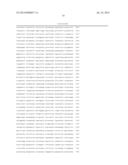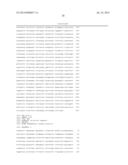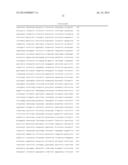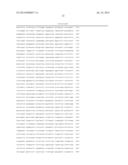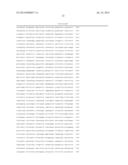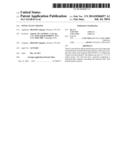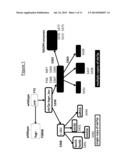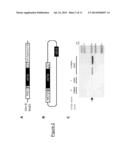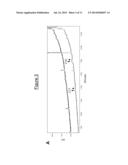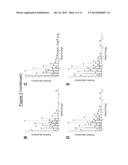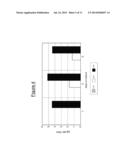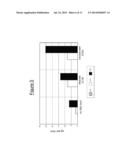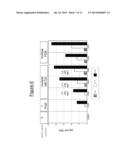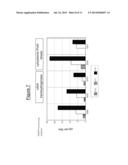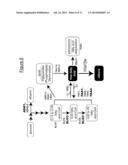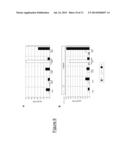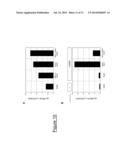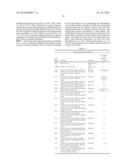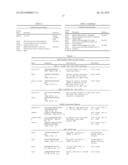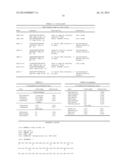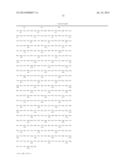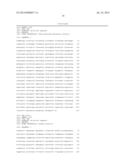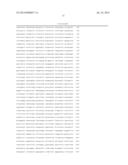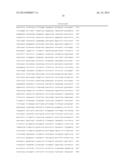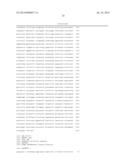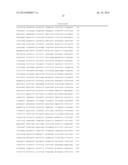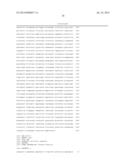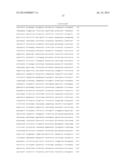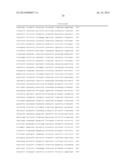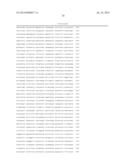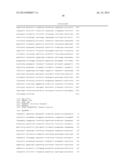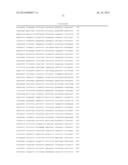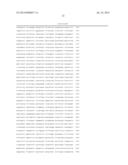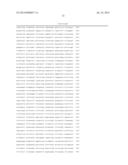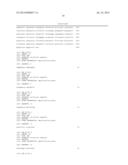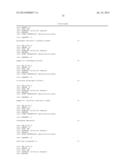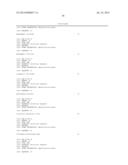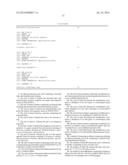Patent application title: NOVEL YEAST STRAINS
Inventors:
Annette Alcasabas (Cambridge, GB)
Paula Isabela Darley (Ware, GB)
Pinar Pir (Cambridge, GB)
Assignees:
SHELL OIL COMPANY
IPC8 Class: AC12P502FI
USPC Class:
435167
Class name: Micro-organism, tissue cell culture or enzyme using process to synthesize a desired chemical compound or composition preparing hydrocarbon only acyclic
Publication date: 2014-07-24
Patent application number: 20140206057
Abstract:
There is provided an alkene-producing yeast cell comprising a bacterial
fatty acid decarboxylase enzyme, which may comprise the amino acid
sequence SEQ ID NO:1 or a functional variant or portion thereof. The
alkene may have 15, 17 or 19 carbon atoms. The cell may have a genome
comprising a polynucleotide sequence encoding the bacterial fatty acid
decarboxylase enzyme.Claims:
1. An alkene-producing yeast cell comprising a bacterial fatty acid
decarboxylase enzyme.
2. The cell of claim 1 wherein the bacterial fatty acid decarboxylase enzyme comprises the amino acid sequence shown in SEQ ID NO:1.
3. The cell of claim 1 further comprising a polynucleotide encoding the bacterial fatty acid decarboxylase enzyme.
4. The cell of claim 3 wherein the polynucleotide comprises the nucleic acid sequence shown in SEQ ID NO:2.
5. The cell of claim 3 having a genome comprising the polynucleotide.
6. The cell of claim 1, wherein the cell is a Saccharomyces cell.
7. The cell of claim 1, wherein the cell is an oleaginous yeast cell.
8. The cell of claim 7 wherein the oleaginous yeast cell is a member of a genus selected from the group consisting of Yarrowia, Candida, Rhodotorula, Rhodosporidium, Cryptococcus, Trichosporon, and Lipomyces.
9. The cell of claim 8, wherein the cell is of the species selected from the group consisting of Lipomyces starkeyi, Rhodosporidium toruloides, Rhodotorula glutinis, and Yarrowia lipolytica.
10. The cell of claim 1 further comprising at least one copy of a plasmid having nucleotide sequence SEQ ID NO:3 or 4 or a functional variant or portion thereof.
11. The cell of claim 1 wherein the alkene produced by the cell is a terminal alkene.
12. The cell of claim 1 wherein the alkene produced by the cell has 15, 16, 17, 18 or 19 carbon atoms.
13. The cell of claim 1 further comprising a modification to provide an internal free fatty acid pool greater than the pool in a non-modified equivalent cell.
14. The cell of claim 13 wherein the modification comprises a disruption of an elo3 gene or a homologous gene thereof.
15. The cell of claim 13 wherein the modification comprises disruption of a faa1 and a faa4 gene or a homologous gene thereof.
16. The cell of claim 1 further comprising a modification to disrupt conversion of acetaldehyde to ethanol by the cell.
17. The cell of claim 16 wherein the modification comprises a disruption of an adh gene or a homologous gene thereof.
18. The cell of claim 1 further comprising a modification to provide an internal oxygen concentration greater than the concentration in a non-modified equivalent cell.
19. The cell of claim 18 wherein the modification comprises a disruption of a mitochondrial dehydrogenase-encoding gene.
20. A method of preparing an alkene comprising culturing an alkene-producing yeast cell comprising a bacterial fatty acid decarboxylase enzyme.
21. The method of claim 20 wherein the cell is cultured in a medium comprising at least one fatty acid.
22. The method of claim 21 wherein the fatty acid comprises 16, 17, 18, 19 or 20 carbon atoms.
23. The method of claim 20 further comprising isolating an alkene from the cell by a cell lysis method which does not include use of a detergent and a reducing agent.
24. The method of claim 23 wherein the reducing agent is tris(hydroxypropyl)phosphine.
25. The method of claims 23 comprising lysing the cell by agitation with glass beads.
Description:
CROSS-REFERENCE TO RELATED APPLICATIONS
[0001] This application claims priority to European Patent Application No. 12199839.7, filed on Dec. 31, 2012, the disclosure of which is incorporated herein by reference.
TECHNICAL FIELD
[0002] The present disclosure relates to novel yeast strains useful for the production of alkenes, which are useful in the production of biofuels and/or biochemicals.
BACKGROUND
[0003] This section is intended to introduce various aspects of the art, which may be associated with exemplary embodiments of the present invention. This discussion is believed to assist in providing a framework to facilitate a better understanding of particular aspects of the present invention. Accordingly, it should be understood that this section should be read in this light, and not necessarily as admissions of any prior art.
[0004] With the diminishing supply of crude mineral oil, use of renewable energy sources is becoming increasingly important for the production of liquid fuels and/or chemicals. These fuels and/or chemicals from renewable energy sources are often referred to as biofuels. Biofuels and/or biochemicals derived from non-edible renewable energy sources are preferred as these do not compete with food production.
[0005] Alkenes are important constituents in the production of fuels and/or chemicals. It would therefore be desirable to produce alkenes (sometimes also referred to as bio-alkenes) from non-edible renewable energy sources.
[0006] U.S.2011/0196180 describes compositions and methods for producing bio-olefins. It describes the discovery of a novel gene, orf880, which encodes an olefin-producing enzyme. Polynucleotides described may be isolated from a bacterium, such as for example a bacterium of the genus Jeotgalicoccus. U.S.2011/0196180 describes a recombinant vector including the polynucleotide and a host cell comprising such a recombinant vector. Such host cell may express a polypeptide encoded by the recombinant vector. In U.S.2011/0196180 the heterologous expression of the orf880 gene of the bacterium Jeotgalicoccus ATCC 8456 in another bacterium, such as E. coli is exemplified. In passing, U.S.2011/0196180 also mentions a prophetic example (example 11), which suggests the production of alfa-olefins in Saccharomyces cerevisiae by heterologous expression, via a yeast expression vector, of Jeotgalicoccus sp. ATCC8456 orf880. Without wishing to be bound by any kind of theory, however, one skilled in the art may expect that it cannot successfully carry out this prophetic example. On the contrary, the method proposed in this example 11 for isolating alkenes, if they were indeed to be produced when using the prophetic example method, would be unlikely to be successful, because the YeastBuster® extraction system suggested in the example makes use of detergent, which may be expected to bind to alkenes.
[0007] In addition to the use of a recombinant vector, U.S.2011/0196180 also mentions that the polynucleotide may be stably incorporated into the genomic DNA of the host cell. U.S.2011/0196180, however, provides no practical way of actually carrying out this wish.
[0008] It would be an advancement in the art to provide a yeast cell capable of producing alkenes in good yields. In addition, it would be an advancement in the art to provide a yeast cell capable of producing alkenes without making use of a heterologous expression vector.
SUMMARY
[0009] A first aspect of the present disclosure provides an alkene-producing yeast cell comprising a bacterial fatty acid decarboxylase enzyme. The bacterial fatty acid decarboxylase enzyme may comprise the amino acid sequence SEQ ID NO:1 (the OleTje enzyme from the bacterium Jeotgalicoccus) or a functional variant or portion thereof.
[0010] In the bacterium Jeotgalicoccus, the last enzyme involved in alkene synthesis is a cytochrome P450 peroxygenase, OleTje, which decarboxylates fatty acid and produces carbon dioxide and a terminal alkene. Rude et al. (2011, Appl. Environ. Microbiol. vol. 77 p 1718-1727) have shown that this enzyme enables E. coli to produce alkenes from its own fatty acids.
[0011] The present inventors introduced recombinant OleTje into S. cerevisiae and successfully detected production of terminal alkenes by this organism. Alkenes ranging from C15 to C19 were identified in yeast cell lysates.
[0012] This is surprising, since not all genes that can be expressed in E. coli can be expressed as functional proteins in yeasts such as S. cerevisiae. Among potential problems are improper protein folding, lack of the necessary co-factors, difference in post-translational modification and protein degradation (reviewed by Romanos et al. (1992) Yeast vol. 8 p 423-488; Cereghino et al. (1999) Curr. Op. Biotechnol. vol. 10 p 422-427). These can lead to reduced protein production or inactive protein production. One example is the E. coli xylose isomerase gene which, although it can be expressed in S. cerevisiae, results in a protein which is inactive (Sarthy et al. (1987) Appl. Env. Microbiol. vol. 52 p 1996-2000). This is also true for the Bacillus xylose isomerase, which is functional in E. coli but not S. cerevisiae (Amore et al. (1989) Appl. Microbiol. Biotechnol. vol. 30 p 351-357).
[0013] The inventors expressed OleTje in S. cerevisiae by way of introducing a polynucleotide encoding the enzyme into the yeast genome. This is contrast to work proposed in prophetic Example 11 of U.S.2011/0196180, which suggested use of an expression vector carrying a polynucleotide encoding OleTje.
[0014] In one embodiment, there is provided an alkene-producing yeast cell comprising a bacterial fatty acid decarboxylase enzyme. In one embodiment, the bacterial fatty acid decarboxylase enzyme comprises the amino acid sequence SEQ ID NO:1 or a functional variant or portion thereof. In one embodiment, the cell comprises a polynucleotide encoding the bacterial fatty acid decarboxylase enzyme. In one embodiment, the polynucleotide comprises SEQ ID NO:2 or a functional variant or portion thereof. In one embodiment, the cell has a genome comprising the polynucleotide. In one embodiment, the cell is a Saccharomyces cell or an oleaginous yeast cell. In one embodiment, the cell is a member of the genus Yarrowia, Candida, Rhodotorula, Rhodosporidium, Cryptococcus, Trichosporon, or Lipomyces. In one embodiment, the cell is of the species Lipomyces starkeyi, Rhodosporidium toruloides, Rhodotorula glutinis, or Yarrowia lipolytica.
[0015] In one embodiment, the cell comprises at least one copy of a plasmid having nucleotide sequence SEQ ID NO:3 or 4 or a functional variant or portion thereof. In one embodiment, the alkene is a terminal alkene. In one embodiment, the alkene has 15, 16, 17, 18 or 19 carbon atoms. In one embodiment, the alkene has 15, 17 or 19 carbon atoms.
[0016] In one embodiment, the cell comprises a modification to provide an internal free fatty acid pool greater than the pool in a non-modified equivalent cell. In one embodiment, the cell comprises a disruption of an elo3 gene or a homologous gene thereof. In another embodiment, the cell comprises a disruption of a faa1 and a faa4 gene or a homologous gene thereof. In another embodiment, the cell comprises a modification to disrupt conversion of acetaldehyde to ethanol by the cell. In yet another embodiment, the cell comprises a disruption of an adh gene or a homologous gene thereof.
[0017] In one embodiment, the cell comprises a modification to provide an internal oxygen concentration greater than the concentration in a non-modified equivalent cell. In one embodiment, the cell comprises a disruption of a mitochondrial dehydrogenase-encoding gene.
[0018] In one embodiment, there is provided a method of preparing an alkene comprising culturing a cell as described herein. In one embodiment, the cell is cultured in a medium comprising at least one fatty acid. In one embodiment, the fatty acid comprises 16, 17, 18, 19 or 20 carbon atoms. In one embodiment, the method further comprises isolating an alkene from the cell by a method comprising a cell lysis method which does not include use of a detergent and a reducing agent. In one embodiment, the reducing agent is tris(hydroxypropyl)phosphine. In one embodiment, the method further comprises lysing the cell by agitation with glass beads.
[0019] In one embodiment, there is provided a method of producing an alkane, the method comprises hydrogenation of an isolated alkene produced by a cell described herein and/or in a method described herein. In one embodiment, there is provided a method of producing a branched alkane, the method comprises hydroisomerization of an isolated alkene produced by a cell a cell described herein and/or in a method described herein. In one embodiment, there is provided a method for the production of a biofuel and/or a biochemical comprising combining an alkene produced by a cell described herein and/or in a method described herein or an alkane produced in a method described herein with one or more additional components to produce a biofuel and/or biochemical. In one embodiment, there is provided use of a cell described herein as a biofuel/biochemical alkene precursor source.
BRIEF DESCRIPTION OF THE DRAWINGS
[0020] The following figures are included to illustrate certain aspects of the present disclosure, and should not be viewed as exclusive embodiments. The subject matter disclosed is capable of considerable modifications, alterations, combinations, and equivalents in form and function, as will occur to one having ordinary skill in the art and the benefit of this disclosure.
[0021] FIG. 1 shows lineage of strains constructed in this study from the parental FY2 strain.
[0022] FIG. 2 shows oleTje DNA constructs and expression in yeast, with A being a diagram of the chromosomal targeting construct used to introduce OleTje to yeast strain FY2 to create strain S368, B shows the OleTje overexpression construct pS362, a 2μ plasmid with the oleTje gene under the control of the MET25 promoter, C shows Western blot analysis of control strain YSBN8, single copy strain S368 and multiple copy strain S365.
[0023] FIG. 3A shows GC trace of oleTje strain S368 (lower trace) and control strain YSBN8 (upper trace), terminal alkenes 1-heptadecene (C17, 13.55 minutes) and 1-nonadecene (C19, 17 9 minutes) being marked with arrows, circles mark possible dienes, heptadecadiene (13.85 minutes) and nonadecadiene (18.1 minutes).
[0024] FIG. 3B shows mass spectrum of the peak at 17.9 min, identified as 1-nonadecene.
[0025] FIG. 3C shows mass spectrum of 2-methyl 5 octadecene standard, isomeric to 1-nonadecene.
[0026] FIG. 3D shows mass spectrum of the peak at 13 5 min from stearic acid-fed S368, identified as 1-heptadecene.
[0027] FIG. 3E shows mass spectrum of 1-heptadecene standard.
[0028] FIG. 4 shows the time course of alkene production in the single oleTje copy strain S368.
[0029] FIG. 5 shows that fatty acid feeding increases yield of heptadecene (C17) and nonadecene (C19) in the single oleTje copy strain S368.
[0030] FIG. 6 shows that overexpression of oleTje increases alkene yield.
[0031] FIG. 7 shows that NADPH-producing enzymes do not increase alkene yield in the multicopy oleTje strain S365 background.
[0032] FIG. 8 shows the pathway engineering in the oleTje yeast strains.
[0033] FIG. 9 shows pathway engineering in oleTje yeast strains increases alkene yield.
[0034] FIG. 10 shows that specific mutations increase alkene yield per biomass, in the single copy OleTje background, S368 (A) and combined with OleTje overexpression in the S365 background (B).
DETAILED DESCRIPTION
[0035] Unless otherwise defined herein, scientific and technical terms used herein will have the meanings that are commonly understood by those of ordinary skill in the art.
[0036] Generally, nomenclatures used in connection with techniques of biochemistry, enzymology, molecular and cellular biology, microbiology, genetics, protein and nucleic acid chemistry and hybridization, described herein, are those well known and commonly used in the art.
[0037] Conventional methods and techniques mentioned herein are explained in more detail, for example, in Sambrook et al. (Molecular Cloning, a laboratory manual [second edition] Sambrook et al. Cold Spring Harbor Laboratory, 1989).
[0038] In this specification, SEQ ID NO:1 provides the amino acid sequence of the bacterial enzyme OleTje (Accession no. for the amino acid sequence is HQ709266) and SEQ ID NO:2 provides a S. cerevisiae codon-optimised DNA sequence encoding the OleTje protein, including a streptavidin tag-encoding sequence at the 5' end (resides 1-33 of SEQ ID NO:2). The identity of other amino acid and nucleotide sequences referred to in this specification is as set out in Tables 2 and 3 at the end of the description. The terms "polynucleotide", "polynucleotide sequence" and "nucleic acid sequence" are used interchangeably herein. The terms "polypeptide", "polypeptide sequence" and "amino acid sequence" are, likewise, used interchangeably herein.
[0039] The cell according to the invention may be a recombinant cell. It may be a Saccharomyces cell or an oleaginous yeast cell. The oleaginous yeast cell may be a member of the genus Yarrowia, Candida, Rhodotorula, Rhodosporidium, Cryptococcus, Trichosporon, or Lipomyces and may be, by way of non-limiting example, a cell of the species Lipomyces starkeyi, Rhodosporidium toruloides, Rhodotorula glutinis, or Yarrowia lipolytica.
[0040] The cell may comprise a polynucleotide encoding the bacterial fatty acid decarboxylase enzyme. For example, the polynucleotide may comprise SEQ ID NO:2 or a functional variant or portion thereof. The polynucleotide may be included within (i.e., incorporated into) the genome of the cell. Therefore, the cell may have a genome comprising a polynucleotide encoding the bacterial fatty acid decarboxylase enzyme, such as a polynucleotide having sequence SEQ ID NO:2 or a functional variant or portion thereof. Advantages of preparing a cell according to the invention by means of inclusion in the cell genome of a polynucleotide encoding the bacterial fatty acid decarboxylase enzyme include the stable inheritance of the polynucleotide. This removes any need to carry out constant selection in order to maintain a vector. Furthermore, incorporation of a polynucleotide into the genome ensures a stable copy number, whereas vector copy number can fluctuate in cultures.
[0041] In particular embodiments, the cell may be transformed with and/or comprise at least one copy of a plasmid having nucleotide sequence SEQ ID NO:3 or 4 (pS362 and pS363, respectively), or a functional variant or portion of either of these.
[0042] The present invention also encompasses a cell comprising functional variants or portions of the bacterial fatty acid decarboxylase enzyme. As used herein, a "variant" means an enzyme in which the amino acid sequence differs from the base sequence from which it is derived in that one or more amino acids within the sequence are substituted for other amino acids, or deleted. For example, a variant of SEQ ID NO:1 may have an amino acid sequence at least about 60% identical to SEQ ID NO:1, for example, at least about 65%, 70%, 75%, 80%, 85%, 90%, 91%, 92%, 93%, 94%, 95%, 96%, 97%, 98%, 99% or about 100% identical. This may be the consequence of substitutions or deletions of amino acids within the original sequence SEQ ID NO:1. The variants or portions are functional variants or portions in that the variant sequence has similar or, preferably, identical functional fatty acid decarboxylase activity characteristics to the enzyme having the non-variant amino acid sequence (and this is the meaning of the term "functional variant or portion" as used throughout this specification). The similar or identical fatty acid decarboxylase characteristics as SEQ ID NO:1, mentioned above, may be assessed, for example, by comparing the rate of conversion of eicosanoic acid (C20) to nonadecene (C19) by a variant, to the rate achieved by SEQ ID NO:1 itself. For a functional variant, this rate may be the same or similar, for example at least about 60%, 70%, 80%, 90%, 95% or about 100% the rate achieved by SEQ ID NO:1. A functional variant may also have greater (i.e., an improved) activity than that of SEQ ID NO:1, i.e., the rate of conversion of eicosanoic acid to nonadecene may be more than 100% compared to that of SEQ ID NO:1.
[0043] Amino acid substitutions may be regarded as "conservative" where an amino acid is replaced with a different amino acid with broadly similar properties. Non-conservative substitutions are where amino acids are replaced with amino acids of a different type.
[0044] By "conservative substitution" is meant the substitution of an amino acid by another amino acid of the same class, in which the classes are defined as follows:
TABLE-US-00001 Class Amino acid examples Nonpolar: A, V, L, I, P, M, F, W Uncharged polar: G, S, T, C, Y, N, Q Acidic: D, E Basic: K, R, H
[0045] As is well known to those skilled in the art, altering the primary structure of a polypeptide by a conservative substitution may not significantly alter the activity of that polypeptide because the side-chain of the amino acid which is inserted into the sequence may be able to form similar bonds and contacts as the side chain of the amino acid which has been substituted out. This is so even when the substitution is in a region which is critical in determining the polypeptide's conformation.
[0046] In the present invention, non-conservative substitutions are possible provided that these do not interrupt the enzyme activities of the polypeptides, as defined elsewhere herein.
[0047] Broadly speaking, fewer non-conservative substitutions than conservative substitutions will be possible without altering the biological activity of the polypeptides. Determination of the effect of any substitution (and, indeed, of any amino acid deletion or insertion) is wholly within the routine capabilities of the skilled person, who can readily determine whether a variant polypeptide retains the activity of the non-variant enzyme, as discussed above.
[0048] Using the standard genetic code, further nucleic acid sequences encoding the polypeptides may readily be conceived and manufactured by the skilled person, in addition to those disclosed herein. The nucleic acid sequence may be DNA or RNA and, where it is a DNA molecule, it may for example comprise a cDNA or genomic DNA. The nucleic acid may be contained within an expression vector, such as a plasmid as described elsewhere herein.
[0049] The invention, therefore, encompasses use of variant nucleic acid sequences encoding the polypeptides of the invention. The term "variant" in relation to a nucleic acid sequence means any substitution of, variation of, modification of, replacement of, deletion of, or addition of one or more nucleic acid(s) from or to a polynucleotide sequence, providing the resultant polypeptide sequence encoded by the polynucleotide exhibits at least the same or similar enzymatic properties as the polypeptide encoded by the basic sequence. The term therefore includes allelic variants and also includes a polynucleotide (a "probe sequence") which substantially hybridises to the polynucleotide sequences disclosed herein. Such hybridisation may occur at or between low and high stringency conditions. In general terms, low stringency conditions can be defined as hybridisation in which the washing step takes place in a 0.330-0.825 M NaCl buffer solution at a temperature of about 40-48° C. below the calculated or actual melting temperature (Tm) of the probe sequence (for example, about ambient laboratory temperature to about 55° C.), while high stringency conditions involve a wash in a 0.0165-0.0330M NaCl buffer solution at a temperature of about 5-10° C. below the calculated or actual Tm of the probe sequence (for example, about 65° C.). The buffer solution may, for example, be SSC buffer (0.15M NaCl and 0.015M tri-sodium citrate), with the low stringency wash taking place in 3×SSC buffer and the high stringency wash taking place in 0.1×SSC buffer. Steps involved in hybridisation of nucleic acid sequences have been described for example in Sambrook et al. (as above).
[0050] Typically, nucleic acid sequence variants have about 55% or more of the nucleotides in common with the nucleic acid sequence of the present invention, more typically about 60%, 65%, 70%, 80%, 85%, or even 90%, 95%, 98% or about 99% or greater sequence identity.
[0051] Variant nucleic acids may be codon-optimised for expression in a particular host cell.
[0052] Sequence identity between amino acid and nucleic acid sequences is determined herein by comparing an alignment of the sequences using the Needleman-Wunsch Global Sequence Alignment Tool available from the National Center for Biotechnology Information (NCBI), Bethesda, Md., USA, for example via http://blast.ncbi.nlm nih gov/Blast.cgi, using default parameter settings (for protein alignment, Gap costs Existence:11 Extension:1). Sequence comparisons and percentage identities mentioned in this specification have been determined using this software. When comparing the level of sequence identity to, for example, SEQ ID NO:1, this typically should be done relative to the whole length of SEQ ID NO:1 (i.e., a global alignment method is used). When an equivalent position in the compared sequences is occupied by the same amino acid, then the molecules are identical at that position. Scoring an alignment as a percentage of identity is a function of the number of identical amino acids at positions shared by the compared sequences. When comparing sequences, optimal alignments may require gaps to be introduced into one or more of the sequences, to take into consideration possible insertions and deletions in the sequences. Sequence comparison methods may employ gap penalties so that, for the same number of identical molecules in sequences being compared, a sequence alignment with as few gaps as possible, reflecting higher relatedness between the two compared sequences, will achieve a higher score than one with many gaps. Calculation of maximum percent identity involves the production of an optimal alignment, taking into consideration gap penalties. As mentioned above, the percentage sequence identity may be determined using the Needleman-Wunsch Global Sequence Alignment tool, using default parameter settings. The Needleman-Wunsch algorithm was published in J. Mol. Biol. (1970) vol. 48:443-53.
[0053] The cell according to the invention may produce an alkene which may be a terminal alkene and/or which may have 13, 14, 15, 16, 17, 18, 19, 20, 21, 22 or 23 carbon atoms, preferably 15, 17 or 19 carbon atoms. The alkene may be in linear or branched formation and comprise one or more double bonds. As is well known to the skilled person, an alkene is an unsaturated hydrocarbon comprising at least one carbon-to-carbon double bond. Particular examples of alkenes include straight- or branched-chain alkenes having an odd number of carbon atoms up to about 15, 17 or 19 carbon atoms. Particular examples of the alkenes have just a single inter-carbon double bond. In some embodiments, the cell produces a mixture of at least two alkenes each having 15, 16, 17, 18 or 19 carbon atoms. In a particular embodiment, where the cell produces a mixture of two or more alkenes, the cell produces an alkene having 19 carbon atoms and one or more further alkenes each having 15, 16, 17 or 18 carbon atoms.
[0054] For example, the cell may produce a mixture of alkenes comprising C17 at a concentration of at least 2 μg per litre of a liquid culture of the cell and C19 at a concentration of at least 5 μg per litre of the liquid culture, after about 2 days from the start of culture growth. In some embodiments, the cell may produce a mixture of alkenes comprising C17 at a concentration of at least about 1.5 μg, 1.6 μg, 1.7 μg, 1.8 μg, 1.9 μg, 2.0 μg, 2.5 μg, 3.0 μg, 3.5 μg, 4.0 μg, 4.5 μg, 5.0 μg, 5.5 μg, 6.0 μg, 6.1 μg, 6.2 μg, 6.3 μg, 6.4 μg or at least about 6.5 μg per litre of a liquid culture of the cell, after about 3 days from the start of culture growth. The mixture of alkenes may comprise C19 at a concentration of at least about 9 μg, 10 μg, 11 μg, 12 μg, 13 μg, 14 μg, 15 μg, 16 μg, 17 μg, or at least about 18 μg per litre of liquid culture, after about 3 days from the start of culture growth. In some embodiments, total alkene concentration may be at least about 30 μg, 31 μg, 32 μg, 33 μg, 34μ or at least about 35 μg per litre of liquid culture.
[0055] Total alkene yield may be at least about 0.5 μg/g dry cell mass, or at least about 1.3 μg/g, 1.4, 1.5, 1.6, 1.7, 1.8, 1.9, 2.0, 2.1, 2.2, 2.5, 3.0, 3.5, 4.0, 4.5, 5.0, 5.5, 6.0, 6.5, 7.0, 7.5, 8.0, 8.5, 9.0, 9.5, 10.0, 15.0, 20.0, 21.0, 22.0, 23.0, 24.0, or at least about 25.0 μg alkene per gram of dry cell mass.
[0056] The cell according to the invention may also comprise a modification to provide an internal free fatty acid pool greater than the pool in a non-modified equivalent cell. The term "modification" as used herein in relation to cells indicates that the cell has been altered in some way so as to alter the nucleic acid and/or polypeptide content of the cell in such a way as to cause a change in phenotype (in this case, the level of the internal free fatty acid pool). Such a modification may include, for example, a partial or whole deletion of a gene or other polynucleotide, which may result in the presence, absence or modification of a polypeptide sequence. A "non-modified equivalent cell" is a cell which is identical to the modified cell apart from the modification concerned.
[0057] Reference to "internal free fatty acid pool" indicates the concentration of free fatty acids within a cell, which may be determined using a gas chromatography method such as is described herein. An alternative method is as described in Sakuradani et al. (1999, Eur. J. Biochem. vol. 261 p 812-820). The fatty acid or acids contained in the fatty acid pool may be selected from fatty acids comprising 16, 17, 18, 19 or 20 carbon atoms. In the absence of additional modifications, fatty acids found in yeast cells typically have an even number of carbon atoms.
[0058] By way of example, a cell comprising a modification to provide an internal free fatty acid pool may comprise a disruption of an elo3 gene or a homologous gene thereof. The gene elo3 is the S. cerevisiae gene (NCBI Gene ID851087) which encodes a long chain acyl elongase. Disruption of this gene increases the pool of fatty acids having, for example, 20 carbon atoms. Homologous genes are found in other yeasts and can be readily identified by the skilled person. (For example, suitable genes may include putative elongation of fatty acids protein ELOH1 from Schizosaccharomyces pombe, UniProt ID Q9UTF7; unreviewed protein with UniProt ID Q6CDY7 from Yarrowia lipolytica; UniProt C5M5P9 from Candida tropicalis; UniProt Q6FT73 from Candida glabrata, uncharacterized fatty acid elongases from Pichia spp. with UniProt IDs E7RBX9, Q50L63, C4R3Y7, F2QVY3) A cell comprising such a modification may produce total alkene at least about 116 μg/litre of liquid cell culture after about 3 days from the start of culture growth, equivalent to 23 μg alkene per gram of dry cell weight. This may represent about a 10-, 20-, 30-, 40- or about a 50-fold increase in comparison to the total alkene production of a non-modified equivalent cell.
[0059] "Disruption" of a gene, as referred to throughout this specification, indicates that the activity of the gene is reduced in some way. For example, the gene may be wholly or partially absent from the cell, as compared to an equivalent cell which does not comprise the modification, or the sequence of the gene may be altered so as to reduce activity (for example, the level of transcription achieved from the gene by the cell). Therefore, this encompasses deletion of, substitution of and addition of nucleotides within the gene.
[0060] Alternatively or additionally to the disruption of an elo3 gene or homologous gene, a cell comprising a modification to provide an internal free fatty acid pool may comprise a disruption of both a faa1 and a faa4 gene or of the homologous genes thereof. The genes faa1 and faa4 are S. cerevisiae genes encoding acyl-CoA synthetases. The S. cerevisiae gene fat1 (UniProt ID P38225), also encoding an acyl-CoA synthetase, may also be suitable. Homologous genes are found in other yeasts and can be readily identified by the skilled person. (For example, suitable genes may include Long-chain-fatty-acid-CoA ligase 1 (UniProt ID C5MID6) from Candida tropicalis, unreviewed protein (UniProt ID Q6C8Q3 or YALIOD17864p) from Yarrowia lipolytica, LCF1 (UniProt ID 060135) and LCF2 (UniProt ID Q9P7D7) from Schizosaccharomyces pombe, long chain fatty acyl-CoA synthetase (UniProt ID C4R1R9) from Komagataella pastoris, long chain fatty acyl-CoA synthetase(UniProt ID E7RA39) from Pichia augusta.) A cell comprising such a modification may produce total alkene at 96 μg/litre of liquid cell culture after about 3 days, equivalent to 6 μg alkene per gram of dry cell weight. This may represent about a 3-, 4-, 5-, 6-, 7-, 8-, 9-, 10-, 11-, 12-, 13-, 14- or about a 15-fold increase in comparison to the total alkene production of a non-modified equivalent cell.
[0061] Alternatively or additionally, a cell according to the invention may comprise a modification to disrupt conversion of acetaldehyde to ethanol by the cell. "Disrupt conversion" indicates that the pathway of conversion of acetaldehyde to ethanol in the cell is disrupted so that a reduced amount or no ethanol is produced from acetaldehyde by the cell, in comparison to the amount produced in the absence of the modification. For example, the cell may comprise a disruption of an adh gene or a homologous gene thereof. The gene adh1 is a S. cerevisiae gene encoding an alcohol dehydrogenase. Homologous genes are found in other yeasts and can be readily identified by the skilled person. A cell comprising such a modification may produce total alkene at at least about 1.1 μg, 1.2 μg, 1.3 μg, 1.4 μg or at least about 1.5 μg/g dry cell weight after about 3 days from the start of culture growth
[0062] Alternatively or additionally, a cell according to the invention may comprise a modification to provide a predicted internal oxygen concentration greater than the predicted concentration in a non-modified equivalent cell. The internal oxygen concentration may be determined through metabolic modelling, specifically flux balance analysis (FBA) (see, for example, U.S. Pat. No. 7,751,981). For example, the cell may comprise a disruption of a mitochondrial dehydrogenase-encoding gene such as the S. cerevisiae gene mtd1 or homologues from other yeasts.
[0063] Particular examples of cells according to embodiments of the invention include strains having the genotypes of S364, S365, S366, S367, S368, S431, S432, and S437 as set out in Table 1 below, especially S431 (genotype MATα ura3-52 leu2Δ::PGKp-oleTje::hph elo3Δ::kanMX4+plasmid S362 2μ(LEU2, MET25p-oleTje)) and S437 (genotype MATα ura3-52 leu2Δ::PGKp-oleTj e::hph faa1Δ::kanMX4 faa4Δ::natMX +plasmid S362 2μ(LEU2, MET25p-oleTje)).
[0064] According to a second aspect of the invention, there is provided a method of preparing an alkene comprising culturing a cell according to the first aspect of the invention. The term "culturing a cell" indicates growing a cell or a sample of cells in liquid media or on a solid medium such as an agar plate. This may be done under controlled conditions such as at a fixed temperature (30° C. is typical) and/or fixed oxygen concentration, for example. The contents of the solid or liquid media may be altered by the user to affect the growth or other aspects of the phenotype of the cells. Such culturing methods are extremely well understood by the skilled person and particular details of suitable methods are also referred to in the Examples below.
[0065] The method according to the second aspect of the invention may subsequently comprise isolating the alkene and/or mixture of alkenes. The term "isolating the alkene" indicates that the alkene, or mixture of alkenes, is separated from other non-hydrocarbon components. This may indicate that, for example, at least about 50% by weight of a sample after separation is composed of the alkene(s), for example, at least about 60%, 70%, 75%, 80%, 85%, 90%, 95%, 96%, 97%, 98% 99% or 100%. The alkene produced during the working of the invention can be separated (i.e., isolated) by any known technique. One exemplary process is a two-phase (bi-phasic) separation process, involving conducting the method for a period and/or under conditions sufficient to allow the alkene(s) to collect in an organic phase and separating the organic phase from an aqueous phase. This may be especially relevant in the context of alkene production by a yeast cell, as is the case in the present invention. Bi-phasic separation uses the relative immiscibility of hydrocarbons to facilitate separation "Immiscible" refers to the relative inability of a compound to dissolve in water and is defined by the compound's partition coefficient, as will be well understood by the skilled person.
[0066] In an embodiment, the further step of isolating the alkene may comprise a step of lysing the cell or cells, which is preferably achieved by a method which does not involve use of a detergent and/or a tris(hydroxypropyl)phosphine (THP) reducing agent. Cell lysis may be achieved by mixing the cell or cells with beads comprising a hard material such as glass and subjecting the mixture to agitation.
[0067] In the method according to the second aspect of the invention, the cell or cells may be cultured in a medium comprising at least one fatty acid, for example a fatty acid comprising 16, 17, 18, 19 or 20 carbon atoms. This assists with maximising the internal free fatty acid pool in the cell, so that the concentration of the fatty acid substrate is not the rate limiting factor on enzyme activity. Culturing (or "feeding") with a fatty acid having an odd number of carbon atoms, not naturally present in yeast, will enable production of an alkene having an even number of carbon atoms. Suitable methods are disclosed, for example, in Dittrich et al. (1998; Eur. J. Biochem. vol. 25 p 477-485).
[0068] According to a third aspect of the invention, there is provided a method of producing an alkane, comprising hydrogenation of an isolated alkene produced by a cell according to the first aspect of the invention and/or in a method according to the second aspect of the invention.
[0069] The unsaturated bonds in the isolated alkene can be hydrogenated to produce the alkane. Hydrogenation may be carried out in any manner known by the person skilled in the art to be suitable for hydrogenation of unsaturated compounds. The hydrogenation catalyst can be any type of hydrogenation catalyst known by the person skilled in the art to be suitable for this purpose. The hydrogenation catalyst may comprise one or more hydrogenation metal(s), for example, supported on a catalyst support. The one or more hydrogenation metal(s) may be chosen from Group VIII and/or Group VIB of the Periodic Table of Elements. The hydrogenation metal may be present in many forms; for example, it may be present as a mixture, alloy or organometallic compound. The one or more hydrogenation metal(s) may be chosen from the group consisting of Nickel (Ni), Molybdenum (Mo), Tungsten (W), Cobalt (Co) and mixtures thereof. The catalyst support may comprise a refractory oxide or mixtures thereof, for example, alumina, amorphous silica-alumina, titania, silica, ceria, zirconia; or it may comprise an inert component such as carbon or silicon carbide.
[0070] The temperature for hydrogenation may range from, for example, 300° C. to 450° C., for example, from 300° C. to 350° C. The pressure may range from, for example, 50 bar absolute to 100 bar absolute, for example, 60 bar absolute to 80 bar absolute.
[0071] A fourth aspect of the invention provides a method of producing a branched alkane, comprising hydroisomerization of an isolated alkene produced in by a cell according to the first aspect of the invention and/or a method according to a second aspect of the invention, or an alkane produced in a method according to the third aspect of the invention. Hydroisomerization may be carried out in any manner known by the person skilled in the art to be suitable for hydroisomerization of alkanes. The hydroisomerization catalyst can be any type of hydroisomerization catalyst known by the person skilled in the art to be suitable for this purpose. The one or more hydrogenation metal(s) may be chosen from Group VIII and/or Group VIB of the Periodic Table of Elements. The hydrogenation metal may be present in many forms, for example it may be present as a mixture, alloy or organometallic compound. The one or more hydrogenation metal(s) may be chosen from the group consisting of Nickel (Ni), Molybdenum (Mo), Tungsten (W), Cobalt (Co) and mixtures thereof. The catalyst support may comprise a refractory oxide, a zeolite, or mixtures thereof. Examples of catalyst supports include alumina, amorphous silica-alumina, titania, silica, ceria, zirconia; and zeolite Y, zeolite beta, ZSM-5, ZSM-12, ZSM-22, ZSM-23, ZSM-48, SAPO-11, SAPO-41, and ferrierite.
[0072] Hydroisomerization may be carried out at a temperature in the range of, for example, from 280 to 450° C. and a total pressure in the range of, for example, from 20 to 160 bar (absolute).
[0073] In one embodiment, hydrogenation and hydroisomerization are carried out simultaneously.
[0074] A fifth aspect of the invention provides a method for the production of a biofuel and/or a biochemical comprising combining an alkene produced by a cell according to the first aspect of the invention and/or in a method according to the second aspect of the invention with one or more additional components to produce a biofuel and/or biochemical.
[0075] According to a sixth aspect of the invention, there is provided a method for the production of a biofuel and/or a biochemical comprising combining alkane produced according to the third or fourth aspects with one or more additional components to produce a biofuel and/or biochemical.
[0076] In the fifth and sixth aspects, the alkane and/or alkene can be blended as a biofuel component and/or a biochemical component with one or more other components to produce a biofuel and/or a biochemical. By a biofuel or a biochemical, respectively, is herein understood a fuel or a chemical that is at least partly derived from a renewable energy source. Examples of one or more other components with which the alkane and/or alkene may be blended include anti-oxidants, corrosion inhibitors, ashless detergents, dehazers, dyes, lubricity improvers and/or mineral fuel components, but also conventional petroleum derived gasoline, diesel and/or kerosene fractions.
[0077] A further aspect of the invention provides the use of a cell according to the first aspect of the invention as a biofuel/biochemical alkene precursor source. A "biofuel/biochemical alkene precursor" is an alkene or mixture of alkenes, which may be used in the preparation of a biofuel and/or a biochemical, for example in a method according to the fifth or sixth aspects of the invention. The use of a cell as the source of such a precursor indicates that the cell according to the first aspect of the invention produces alkenes suitable for use in the biofuel/biochemical production methods, the alkenes being isolatable from the cell as described elsewhere herein.
[0078] Throughout the description and claims of this specification, the words "comprise" and "contain" and variations of the words, for example "comprising" and "comprises", mean "including but not limited to" and do not exclude other moieties, additives, components, integers or steps. Throughout the description and claims of this specification, the singular encompasses the plural unless the context otherwise requires. In particular, where the indefinite article is used, the specification is to be understood as contemplating plurality as well as singularity, unless the context requires otherwise.
[0079] Preferred features of each aspect of the invention may be as described in connection with any of the other aspects.
[0080] Other features of the present invention will become apparent from the following examples. Generally speaking, the invention extends to any novel one, or any novel combination, of the features disclosed in this specification (including the accompanying claims and drawings). Thus, features, integers, characteristics, compounds or chemical moieties described in conjunction with a particular aspect, embodiment or example of the invention are to be understood to be applicable to any other aspect, embodiment or example described herein, unless incompatible therewith.
[0081] Moreover, unless stated otherwise, any feature disclosed herein may be replaced by an alternative feature serving the same or a similar purpose.
[0082] Embodiments of the invention will now be described, by way of example only, with reference to the following FIGS. 1-10. FIG. 1 shows lineage of strains constructed in this study from the parental FY2 strain. FIG. 2 shows oleTje DNA constructs and expression in yeast, with A being a diagram of the chromosomal targeting construct used to introduce OleTje to yeast strain FY2 to create strain 5368, B shows the OleTje overexpression construct pS362, a 2μ plasmid with the oleTje gene under the control of the MET25 promoter, C shows Western blot analysis of control strain YSBN8, single copy strain S368 and multiple copy strain 5365. FIG. 3A shows GC trace of oleTje strain S368 (lower trace) and control strain YSBN8 (upper trace), terminal alkenes 1-heptadecene (C17, 13.55 minutes) and 1-nonadecene (C19, 17.9 minutes) being marked with arrows, circles mark possible dienes, heptadecadiene (13.85 minutes) and nonadecadiene (18.1 minutes). FIG. 3B shows mass spectrum of the peak at 17.9 min, identified as 1-nonadecene. FIG. 3C shows mass spectrum of 2-methyl 5 octadecene standard, isomeric to 1-nonadecene. FIG. 3D shows mass spectrum of the peak at 13.5 min from stearic acid-fed S368, identified as 1-heptadecene. FIG. 3E shows mass spectrum of 1-heptadecene standard. FIG. 4 shows the time course of alkene production in the single oleTje copy strain S368. FIG. 5 shows that fatty acid feeding increases yield of heptadecene (C17) and nonadecene (C19) in the single oleTje copy strain S368. FIG. 6 shows that overexpression of oleTje increases alkene yield. FIG. 7 shows that NADPH-producing enzymes do not increase alkene yield in the multicopy oleTje strain S365 background. FIG. 8 shows the pathway engineering in the oleTje yeast strains. FIG. 9 shows pathway engineering in oleTje yeast strains increases alkene yield. FIG. 10 shows that specific mutations increase alkene yield per biomass, in the single copy OleTje background, S368 (A) and combined with OleTje overexpression in the S365 background (B).
EXAMPLES
Materials And Methods
Yeast Strain Construction
[0083] Yeast strains (Table 1 below and FIG. 1) were all constructed from strain FY2 (Winston et al. (1995) Yeast vol. 11 p 53-55). The oleTje gene (GenBank HQ709266; Rude et al., 2011) was codon-optimised for S. cerevisiae and synthesized by GeneArt (Invitrogen).
[0084] To introduce the oleTje gene and delete native yeast genes, the inventors used a high-efficiency lithium acetate transformation protocol (Gietz et al. (2007) Nature Protocols vol. 2 p 35-37). Transformed strains (FY2, S368, or S365) were plated out on YPD-agar containing 300 μg/ml hygromicin B (Calbiochem) to select for the hph gene, 200 μg/ml G418 (Sigma) to select for the kan gene, or 100μg/ml clonNAT (Werner Bioagents) to select for the nat1 gene. The oleTje integration construct (FIG. 2A) and high-copy plasmid (FIG. 2B) are described in the Results section below.
[0085] To introduce NADPH-producing enzymes into yeast, the genes udhA and truncated POS5 were amplified using genomic DNA from E. coli strain JM109 and S. cerevisiae strain FY2, respectively, using primers listed in Table 3. They were cloned between the PGK1 promoter and CYC1 terminator into yeast vector pRS426 (Sikorski and Hieter (1989) Genetics vol. 122 p 19-27) and transformed into oleTje yeast strain S365. Transformants were selected on synthetic complete medium without leucine and uracil.
[0086] To delete specific genes in yeast strains harbouring oleTje, deletion constructs of the genes MTD1, ADH1, ELO3 and FAA1 were amplified from genomic DNA of the appropriate strains available through the yeast deletion collection (Open Biosystems; Winzeler et al. (1999) Science vol. 285 p 901-906). PCR products were directly transformed into both S368 and S365, and transformants selected for the kan gene. For FAA4, the faa4 deletant was first converted to carry the nat1 marker (as described by Tong and Boone (2006) Methods in Molecular Biology (Clifton, N.J.), vol. 313 p 171-192). The deletion cassette was then amplified and the PCR product transformed into the oleTje faa1 strains. All deletions were confirmed by colony PCR. All primers are listed in Table 3.
Expression of OleTje In Oleaginous Yeasts
[0087] The expression of oleTje in an oleaginous yeast, such as Yarrowia lipolytica, can be achieved by transformation of a plasmid bearing oleTje under control of the strong promoter Hp4d using the lithium acetate procedure (molecular tools for Yarrowia reviewed by Nicaud (2012) Yeast, 29 (10, 409-418). Alkene production can be tested using the protocols the inventors developed for Saccharomyces cerevisiae. Genetic modifications of the Yarrowia homologues of ELO3 and the FAA genes could also be tested for increased alkene production.
Yeast Media And Culture Conditions
[0088] Yeast strains were grown in synthetic complete (SC) medium without leucine and containing 2% glucose. S365-based strains with oleTje expression driven by the MET25 promoter were grown under either conditions of transcriptional derepression (0.2 mM methionine) or repression (2 mM methionine). In fatty-acid feeding experiments, synthetic complete medium was supplemented with 0.02% fatty acid and 1% tergitol (similar to the media used by Lockshon et al. (2007) Genetics vol. 175 p 77-91). All cultures were grown at 30° C. Liquid cultures (50 to 60 ml) were grown from a starting OD600 of 0.01, in 250 ml flasks at 210 rpm shaking. Cells were collected for alkene extraction after 3 days, with the exception of the time course experiment where collection times are stated.
Heterologous Protein Production And Western Blot Analysis
[0089] In all the DNA constructs, the codon-optimised oleTje gene was fused to an N-terminal streptavidin tag sequence. Total cell protein was extracted from 1 ml of a 24-hour culture, using the trichloroacetic acid precipitation method (Paciotti et al., 1998); protein concentration was measured using the Bradford assay. An aliquot (25 μg) of total protein extract was run on a 10-20% polyacrylamide gel with Tricine buffer (Invitrogen) and transferred onto a PVDF membrane. This was incubated for 1 hour with 1:4000 dilution of Strep-Tactin alkaline phosphatase conjugate (IBA). After washing the membrane, it was incubated in BCIP/NBT substrate solution (Sigma) until distinct bands corresponding to the tagged proteins were visible (10-20 minutes).
Extraction And Quantification of Alkenes
[0090] Alkenes, fatty acid ethyl esters and other hydrophobic metabolites were extracted from yeast cell lysates. Cell pellets from 50 or 60 ml cultures were collected and mixed in glass vials with 100 μl water and 200 μl of acid-washed 0.5 mm glass beads (Biospec). Cells were then lysed by shaking at 5.5 m/s for a total of 3 minutes in a FastPrep (MPBio). Internal standards (5 μg each of tetradecane, tetradecene, ethyl heptanoate, and pentadecanol) and 0.5 ml hexane were added to each vial. Solutions were mixed for 1 hour at 2000 rpm and subsequently frozen for 10 minutes to 2 hours at -80° C. Centrifugation of frozen samples (3600 rpm, 4° C., 25 minutes) was done to separate and collect the hexane layer.
[0091] Hexane extracts were run in a Gas Chromatograph (Perkin Elmer) using a Zebron FFAP column (30 m×0.25 mm×0.25 μm, Phenomenex) with helium at a flow rate of 2.4 ml/min. The temperature profile was as follows: The initial oven temperature was 70° C., it was then ramped up at a rate of 5° C./min to 160° C. In order to obtain a good separation for all standards, a second temperature ramp was needed at a rate of 8° C./min to 250° C. and held at 250° C. for 7 min. Alkenes and other metabolites were identified and quantified against known standards (Table 4). To confirm the identification of alkenes and ethyl esters, selected samples and controls were also run on a GC-MS (Thermofisher DSQII) using the same Zebron FFAP column and temperature profile, flow rate of 1.5ml/min helium, 1 μl cold on-column injection, electron impact ionization, and a scan rate of 45-645 daltons at 0.5 sec/scan. For identification, the mass spectra of selected peaks were compared to a reference library (Stein (retrieved 2012) "Mass Spectra" in NIST Chemistry WebBook, NIST Standard Reference Database Number 69, http://webbook.nist.gov) as well as the mass spectra of known standards.
Flux Balance Analysis
[0092] The S. cerevisiae genome-wide metabolic model iIN800 (Nookaew et al. (2008) BMC Syst. Biol. 2:71; doi: 10.1186/1752-0509-2-71) was downloaded from http://sourceforge.net/projects/yeast/files/other/. The MATLAB/COBRA platform was used to carry out Flux Balance Analysis (FBA). The model was modified for (1) addition of oleTje and (2) gene deletions for relevant auxotrophies. Simultaneous biomass and alkene production was simulated for all single-deletion mutants. Deletion mutants identified by the simulations as increasing alkene production without any major impact on biomass production were selected and tested in vivo. The model was further extended to represent the production of by-products (ethyl esters) found in GC-MS analysis of the cell extracts and further predictions were made.
EXAMPLES
Results
Heterologous oleTje Expression In Yeast
[0093] To test the activity of the OleTje protein in yeast, a single copy of the codon-optimised oleTje gene was integrated into the genome of S. cerevisiae strain FY2 (Winston et al. (1995) Yeast vol. 11 p 53-55). FY2 is derived from S288C, a strain whose complete genome sequence is available (http://www.yeastgenome.org) and this facilitated the design of the constructs for genetic manipulation of the production strain. OleTje was fused to the streptavidin tag and placed under control of the constitutive PGK1 promoter and CYC1 terminator, the genomic integration site was the LEU2 gene on chromosome III (FIG. 2A).
[0094] The resulting strain, 5240 (Table 1), has a complete deletion of the LEU2 gene, resulting in leucine auxotrophy. The inventors took advantage of this phenotype to overexpress oleTje by introducing high copy-number 2μ plasmids bearing both the wild-type LEU2 gene and oleTje into 5240; these plasmids are stably maintained in yeast grown without leucine. 2μ plasmids were also constructed where oleTje is under control of the regulatable promoter MET25 (pS362, FIG. 2B and Table 2) and PGK1 (pS363, Table 2). Strain 5365 contains the pS362, and oleTje expression is induced at methionine concentrations below 0.5 mM (Mumberg et al., 1994). Strain 5368 was also constructed, which contains an integrated copy of oleTje and plasmid pRS425 (Sikorski and Hieter (1989) Genetics vol. 122 p 19-27) to restore leucine prototrophy.
[0095] Both the S368 (single-copy) and S365 (multicopy) strains produced the streptavidin-tagged OleTje protein, visible as a 50 kDa band on the Western blot shown in FIG. 2C; the same size as the recombinant polyhistidine-tagged OleTje produced by Rude and colleagues (2011; Appl. Eviron. Microbiol. vol. 77 p 1718-1727). Strain S368, which only has the single copy of oleTje, produced a small amount of protein, faintly visible on the Western blot under these conditions. S365, bearing multiple copies of the oleTje gene, produced a higher concentration of the protein than S368, even under repressed conditions (2 mM methionine) and protein production was further increased under derepressed conditions (no methionine). YSBN8, a hygromycin-resistant version of FY2, was used as a negative control strain (Canelas et al. (2010) Nature Communs. 1:-; doi:10.1038/ncomms 1150). All strains constructed in this study are listed in Table 1 and their lineage from the original FY2 strain is outlined in FIG. 1.
Alkene Production In the Single Copy oleTje Strain
[0096] Initial experiments were carried out on S368 to determine whether a single copy of the oleTje gene, expressed from a strong constitutive promoter, would be sufficient to produce alkenes in yeast. S368 was grown in SC medium without leucine and with 2% glucose for three days. Using GC analysis on yeast cell extracts, the alkene 1-nonadecene (C19, retention time 17.9 minutes) was observed as the major product, followed by 1-heptadecene (C17, 13.5 minutes); see FIG. 3A. These products were identified based on the retention times of known standards (Table 4) and were subsequently confirmed using GC-MS (FIGS. 3B, 3C, 3D, 3E). The mass spectrum of the peak corresponding to 1-nonadecene (FIG. 3B) is consistent with that of a 19-carbon alkene based on reference spectra from the National Institute of Science and Technology mass spectra database (Stein (retrieved 2012) "Mass Spectra" in NIST Chemistry WebBook, NIST Standard Reference Database Number 69, http://webbook.nist.gov) and is similar to the isomeric standard 2-methyl 5 octadecene (FIG. 3C). There was not enough of the 1-heptadecene peak (C17, 13 5 minutes in FIG. 2A) to be identified using GC-MS; however stearic acid-fed 5368 (described below) produced a higher amount of this peak and its mass spectra (FIG. 3D) is identical to that of the 1-heptadecene standard (FIG. 3E).
[0097] Next, alkene production was quantitated in S368 over the course of three days (FIG. 4). Nonadecene was produced after 1 day, that is, during early stationary phase. Its concentration increased after 2 days to over 5 μg per litre of culture. Heptadecene was observed from 2 days at under 2 μg/litre of culture. The highest level of both alkenes was measured within the cells at 2 days, this dropped by 17% on the third day. This suggests that alkenes are either consumed or secreted by yeast after the second day. The latter was tested by examining alkenes extracted from 1.5 ml samples of medium for all three days; however, they were either absent or their concentration was too low to be detectable using the available extraction and GC protocol (data not shown). Total alkenes produced adjusted for dry cell weight was 0.6 μg/g.
[0098] In yeast, the major fatty acids are C16 and C18, comprising 97% (20% for the saturated forms, 76.6% for the monounsaturated forms) of the free fatty acid pool, whereas C20 represents 0.23% (Oh et al. (1997) J. Bio. Chem. vol. 272 p 17376-17384). It was therefore unexpected to have nonadecene, a product of the saturated C20 fatty acid, as the major alkene product. This suggests a much greater preference of the OleTje enzyme for the C20 fatty acid. In the Rude et al. study mentioned above, OleTje enzyme decarboxylated both C18 and C16 fatty acids in E. coli; however, in Jeotgalicoccus, branched and unbranched forms of the C20 fatty acid are the enzyme's main substrates.
[0099] The mono-unsaturated forms are the most abundant fatty acid species in yeast (typically 80% of total free fatty acids, depending on growth conditions; reviewed in Tehlivets et al. (2007) Biochim et Biophys. Acta. vol. 1771 p 255-270). It was therefore surprising not to find dienes as the major products, since they would be formed by the decarboxylation of abundant fatty acids such as palmitoleic acid (C16) and oleic acid (C18). There were, however, smaller peaks close to heptadecene and nonadecene that are suspected to be dienes. These are heptadecadiene at 13.85 minutes and nonadecadiene at 18.1 minutes (FIG. 3). Unfortunately, these species were present at too low a concentration to be identified by GC-MS, and no commercial diene standards were available with which to compare to their retention times. Their very low abundance suggests that the OleTje enzyme has a stronger preference for saturated fatty acids.
Fatty Acid Feeding Increased Alkene Yield
[0100] As in the Rude et al. study, the inventors examined alkenes produced from yeast grown in media containing stearic acid (C18) or eicosanoic acid (C20) in addition to glucose. A three-fold increase in heptadecene was measured, with a two-fold increase in nonadecene when yeast were grown with stearic acid (FIG. 5). A three-fold increase in heptadecene was also found, with a five-fold increase in nonadecene when yeast are grown with eicosanoic acid. The greater increase in nonadecene further supports the contention that the OleTje enzyme has preference for the C20 fatty acid.
[0101] The inventors also looked at 5368 grown in media containing palmitic acid (C16) and oleic acid (C18:1). Palmitic acid had no effect on the alkene yields; in contrast to feeding Jeotgalicoccus with palmitic acid (Rude et al., as above) no pentadecene was observed in yeast cell extracts (data not shown). Oleic acid also had no impact on alkene yields; however, there was an increase in the GC peak at 13.85 minutes, suggesting an increase in the predicted heptadecadiene product (data not shown).
oleTje Overexpression Increased Product Yield
[0102] As described above, strains were constructed with multiple copies of oleTje, with the expectation that higher production of the enzyme would lead to greater alkene yields. Yeast strains 5364 and 5365 carrying pS362 were also constructed (FIG. 2B, Table 2), with methionine-regulatable expression of oleTje, as well as strains 5366 and 5367 carrying pS363 (Table 2) with constitutive and strong expression of oleTje. The reason for using multiple strains, each an independent transformant of the oleTje 2μ plasmid, is that plasmid copy number can be variable between transformants, and so several were screened for maximal alkene production.
[0103] Alkene production of strains S364 and S365 grown with 0.4mM methionine after 3 days was examined (FIG. 6). Relative to the single-copy oleTje strain S368, S364 showed a modest increase in heptadecene (12%, 1.6 μg/L) and nonadecene (35%, 9 μg/L). S365 was more productive, yielding >4-fold more heptadecene (6.2 μg/L) and >2-fold more nonadecene (17.9 μg/L) than S368. Additionally, S365 was able to produce pentadecene (C15) at 1.6 μg/L. Lowering the methionine concentration to 0.2 mM (to fully derepress oleTje expression) further increased production of all three alkenes to a total titre of 31.6 μg/L, almost 4-fold higher than that achieved by S368.
[0104] Alkene production was next screened in strains 5366 and 5367, which have multiple copies of oleTje under the control of the strong constitutive PGK1 promoter (FIG. 6). Both strains were able to produce alkenes from C15 to C19 at levels well above 5368. The more productive strain is S367, likely due to more copies of the 2μ plasmid, which had a total alkene titre of 35 μg/L or >4-fold higher than that of S368. Total alkene produced, adjusted to dry cell weight, was 0.72 μg/g (S364), 1.3-2.2 μg/g (S365, more usually 1.3-1.6 μg/g), 2.1 μg/g (S366) and 3.5 μg/g (S367).
[0105] Based on these experiments, strain S365 was selected, whose oleTje expression is regulated by methionine, as the strain on which to base further metabolic engineering. Although strain S367 produced a slightly higher titre of alkenes, S365 gave the advantage of modulating oleTje expression, which was necessary when high enzyme activity leads to poor growth in combination with other genetic modifications.
Genetic Engineering Towards Greater Alkene Production
[0106] The aim was to engineer a yeast strain that would generate as much alkene from glucose as possible. The metabolic capability of yeast has been investigated using genome-wide metabolic model iIN800 (Nookaew et al. (2008) BMC Syst. Biol. 2:71; doi:10.1186/1752-0509-2-71). The net stoichiometric equations for production of heptadecene and nonadecene from glucose are as follows:
9 Glucose+2 O2+35 ATP+16 NADPH+18 NAD+->2 Heptadecene+18 NADH+20 CO2+18H2O+2H++16 NADP++35 ADP+35 Pi
10 Glucose+2 O2+39 ATP+18 NADPH+20 NAD+->2 Nonadecene+20 NADH+22 CO2+20H2O+2H++18 NADP++39 ADP+39 Pi
[0107] Using both metabolic modelling and literature searching, a set of mutations was identified that could improve alkene yield by: (1) increasing the cytosolic concentration of NADPH; (2) increasing the intracellular concentration of oxygen by deleting the mitochondrial dehydrogenase gene MTD1; (3) reducing the carbon flux towards ethanol production through deletion of the alcohol dehydrogenase gene ADH1; (4) increasing the total free fatty acid pool through deletion of two genes encoding fatty acyl-CoA synthetases FAA1 and FAA4; and (5) increasing the C20 free fatty acid pool through deletion of ELO3 which encodes a fatty-acid elongase (FIG. 8).
[0108] Deletions at steps (2)-(5) were carried out in both the single-copy oleTje strain S368, as well as the oleTje overexpressing strain S365 (described in Materials and Methods).
NADPH-Producing Enzymes Do Not Increase Alkene Yield
[0109] NADPH is a cofactor in over 50 reactions that are part of fatty acid synthesis and lipid metabolism, while NADH is involved in 8 fatty acid degradation reactions (iIN800, Nookaew et al. (2008), as above). Moreover, eight and nine molecules of NADPH are needed to synthesize one molecule of heptadecene and nonadecene, respectively. Therefore, the inventors examined whether increasing the NADPH/NADH ratio would lead to a higher concentration of free fatty acids, which would subsequently elevate alkene yield. In budding yeast, the majority of NADPH is synthesized in the mitochondria. Cytoplasmic NADPH, once utilised and converted to NADP, cannot be reformed in the cytoplasm. This capability was established in strain 5365 by introducing two genes encoding enzymes that produce NADPH from NADH.
[0110] The first gene encodes the soluble udhA transhydrogenase from E. coli, which interconverts NADH and NADPH. This has been used previously in yeast to either increase cytoplasmic NADPH or reduce NADH (Hou et al. (2009) Metabolic Engineering vol. 11 p 253-261; Toivari et al. (2010) Appl. Microbiol. & Biotechnol. vol 88 p 751-760). The second is a yeast gene, POS5, encoding a mitochondrial NADH kinase that uses ATP to phosphorylate NADH, generating NADPH. A truncated version of POS5 was used, without the mitochondrial targeting sequence; this version of the enzyme is maintained in the cytoplasm (Hou et al., 2009). Both genes were expressed from multicopy plasmids under the control of the strong PGK1 promoter; these plasmids also have the URA3 gene as a selectable marker for growth on media without uracil (plasmids pS263 and pS329, Table 2).
[0111] Metabolic modelling predicted modest increases in metabolic efficiency for production in alkenes in strains transformed with udhA and cytosolic POS5, at 3% and 2%, respectively. Experimentally, two independent transformants carrying the udhA plasmid were screened, strains 5372 and 5373 (FIG. 7). Both strains had a smaller titre of all three alkenes, C15, C17 and C19, relative to the S365 strain. In the Hou et al. study mentioned above, udhA expression had the effect of increasing both glycerol and ethanol production, and the increased flux through these competing pathways could explain the decreased alkene yield. Two independent transformants bearing the cytoplasmic POS5 plasmid, strains 5376 and 5377 were also screened (FIG. 7). Strain S377 had a 45% decrease in total alkene production but S376 produced 37% more alkenes relative to the untransformed S365 strain. The difference between the two POS5-carrying strains could be due to different copy numbers. Total alkene produced, adjusted to dry cell weight, was 1.6 μg/g (S372), 1.4 μg/g (S373), 2.7 μg/g (S376) 1.1 μg/g (S377).
[0112] Thus, by perturbing NADPH and NADH concentrations, at best a 37% increase in alkene production was achieved by expressing a cytoplasmic version of the Pos5 enzyme.
The mtd1 Deletion Has A Modest Effect On Alkene Yield
[0113] The OleTje enzyme requires activated oxygen as a source of electrons for the decarboxylation of fatty acid to alkene (Rude et al. (2011) Appl. Environ. Microbiol. Vol. 77 p 1718-1727). Through metabolic modelling using the model iIN800 (Nookaew et al. (2008) BMC Syst. Biol. 2:71; doi:10.1186/1752-0509-2-71), the inventors identified the mtd1 deletion as a modification that would increase NADPH and oxygen availability for the OleTje reaction. Simulations have predicted that mtd1 deletion mutant can produce 10 times more nonadecene at the late exponential growth phase, without having any growth defects when compared to the parental strain.
[0114] MTD1 encodes a mitochondrial dehydrogenase (West et al, (1993) J. Biol. Chem. vol. 268 p 153-160), whose deletion leads to reduced oxidative phosphorylation within mitochondria. In the computer simulations, this resulted in greater oxygen availability for the OleTje reaction and consequently higher levels of alkenes. Mtd1p catalyses the cytosolic NAD-dependent conversion of 5,10-methylene-THF to 5,10-methenyl-THF, which is an essential reaction in the folate metabolism pathway. In the absence of Mtd1p, an NAD-dependent isoenzyme Ade3p catalyses the same conversion in the cytosol, which is expected to lead to a lower NADH/NAD+ ratio and make less NADH available to respirative metabolism, and eventually to lower respiration capacity with reduced utilization of oxygen. Experimentally, the mtd1 strain showed increased nonadecene production in the single copy oleTje strain background, while heptadecene was reduced (FIG. 9A). In the oleTje overexpression strain, the mtd1 deletion led to slightly reduced levels of pentadecene and nonadecene; however, heptadecene showed a modest increase (FIG. 9B). Based on the modelling predictions, alkene production of both mtd1 strains was also tested, in media supplemented with stearate. However, there was no significant increase in total alkene titres relative to the control strains (data not shown) (total alkene approximately 1.5 μg/g dry cell weight).
[0115] In the inventors' metabolic model, regulatory events are not represented, hence the redox balance of the cells may have shifted to other parts of the metabolism via more complicated routes than the present stoichiometric models can predict (see, for example, Bro et al. (2004) Biotechnology and Bioengineering, 85(3), 269-276. doi:10.1002/bit.10899 and Jouhten et al. (2008) BMC Systems Biology, 2, 60. doi:10.1186/1752-0509-2-60). This does not exclude the possibility that the mtd1 deletion mutant has the metabolic capability of higher alkene yields under well-aerated growth conditions, at higher levels of aeration than were tested experimentally here.
The adh1 Deletion Increases the Alkene Yield Relative To Biomass
[0116] For S. cerevisiae, ethanol is the main product of glucose fermentation. This is true even under aerobic conditions if glucose concentrations are high. Therefore, fermentation is the key competing pathway to alkene production. The last step in ethanol biosynthesis is the reduction of acetaldehyde to ethanol, catalyzed by five yeast Adh enzymes, of which Adh1p plays the major role (reviewed by Leskovac et al. (2002) FEMS Yeast Res. vol. 2 p 481-494). In a previous study, an adh1 deletion was used successfully to reduce ethanol production and enhance the production of another metabolite in an engineered yeast strain (Tokuhiro et al. (2009) Appl. Microbiol. & Biotechnol. vol. 82 p 883-890). The inventors reasoned that deleting ADH1 in the oleTje strains could also lead to increased production of alkenes. This was supported by simulations made using model iIN800, where blocking ethanol production re-directed the carbon flux to other products including alkenes.
[0117] The ADH1 gene was disrupted in the oleTje single-copy strain, 5368. The resulting strain, 5434, is very-slow growing, probably because of the accumulation of acetaldehyde which is toxic to yeast (Marisco et al. (2011) Yeast vol. 28 p 363-373; Tokuhiro et al. (2009), as above). This strain produced only half the total alkene yield of S368 (FIG. 8A); however, it was able to produce the C15 alkene, pentadecene, which had not previously been possible without oleTje overexpression. Additionally, when alkene production was normalised to biomass, the adh1 strain generated twice the total alkene yield of S368, at 1.3 μg/g dry cell weight (FIG. 10A). These results suggest that increasing the growth rate of the adh1 strain, particularly by pushing acetaldehyde utilisation towards fatty acid biosynthesis, could lead to higher alkene production.
Increasing the Total Fatty Acid Pool Boosts Heptadecene
[0118] Through the yeast modelling, the inventors identified a list of enzymes that directly act on the free fatty acid pool (FIG. 8). Of particular interest were the family of fatty acid activating enzymes (Fat1 and Faa1-4), which utilize fatty acid and CoAs to synthesize fatty acyl-CoA (reviewed in Tehlivets et al. (2007) Biochim et Biophys. Acta. vol. 1771 p 2765-2778). Scharnewski et al. (2008; FEBS J. vol. 275 p 2765-2778) have shown that the double deletion, faa1 faa4, leads to elevation of free fatty acids in the yeast cell (approximately 50-fold) and even secretion of fatty acids into the medium. Therefore, the effect of this double deletion on alkene production in the oleTje strains was tested.
[0119] The result of the Scharnewski et al. study was confirmed, that faa1 faa4 strains secrete fatty acid into the culture medium, as evidenced by white precipitates. In the cell lysates, an increase in both saturated and unsaturated C16 and C18 fatty acids and their corresponding ethyl esters was also measured (data not shown). This double mutation also led to a several-fold increase in alkene yield, particularly in heptadecene, in both the 5368 (FIG. 9A) and 5365 (FIG. 9B) background strains. The increase heptadecene yield was over ten-fold, although this was at the expense of a slight reduction in nonadecene production. Interestingly, no significant increase in the pentadecene yield was detected, even though palmitic acid (C16) appeared to be as highly elevated as stearic acid (C18) in the strains. This finding is consistent with the results of the palmitic acid feeding experiment, and confirms the greater preference of OleTje enzyme for stearic acid over palmitic acid. For strain 5437, which combined oleTje overexpression with the faa1 faa4 double mutation, total alkene yield was 96 μg/L, nearly ten-fold greater than that of our initial strain, S368 (FIG. 9B). This corresponds to 6-6.5 μg alkene produced for every gram of dry cell weight, also ten-fold that obtained with S368 (FIG. 10B).
Increasing Cellular C20 Fatty Acid Boosts Nonadecene
[0120] Because the most preferred substrate for OleTje is eicosanoic acid (C20), the inventors searched for a mutation that would increase this particular fatty acid pool. ELO3 was identified, which encodes a long-chain acyl elongase, responsible for the synthesis of very long chain fatty acids ranging from C20 to C26 (Oh et al. (1997) J. Biol. Chem. vol. 272 p 17376-17384). The elo3 null mutant is viable because its activity partially overlaps with another elongase-coding gene, ELO2. However, this mutant shows pleiotropic phenotypes and an altered membrane and lipid profile (Oh et al. (1997), as above; Ejsing et al. (2009) Proc. Natl. Acad. Sci. U.S.A. vol. 106 p 2136-2141). Eicosanoic acid (C20) is elevated, in the elo3 mutant, to a level 5-fold greater than that found in the parental strain (Oh et al. (1997), as above).
[0121] The elo3 mutation led to poor growth in both oleTje strain backgrounds. The oleTje overexpression strain was particularly affected, yielding only one third the biomass of the background strain, S365. This engineered yeast, 5431, displayed the large and elongated cell morphology that is characteristic of yeast undergoing cellular stress (data not shown). Despite this, the elo3 strains produced alkenes at a several-fold greater yield than in background strains, due to elevated nonadecene (FIGS. 9A and 9B). For strain 5431, which combined oleTje overexpression with elo3 deletion, the total alkene yield was 116 μp g/L, which is a >10-fold increase over that of the initial strain, S368 (FIG. 9B). When normalised for biomass, 5431 produced 23 μg of alkenes per gram of dry cell weight, corresponding to a 40-fold increase over the initial strain. This suggests a potential for increasing alkene yield by improving strain biomass; in particular, by turning off ELO3 expression only when the culture has established a particular cell density.
EXAMPLES
Discussion
[0122] The inventors demonstrated production of terminal alkenes in S. cerevisiae through the activity of a fatty acid decarboxylase, OleTje, from the bacterium, Jeotgalicoccus sp. This enzyme has a high preference for eicosanoic acid (C20), followed by stearic acid (C18) and very low activity towards palmitic acid (C16). In contrast to in vitro assays (Rude et al (2011) Appl. Eviron. Microbiol. vol. 77 p 1718-1727), activity towards myristic acid (C14) was not detected, although it is more abundant than eicosanoic acid (Oh et al. (1997) J. Biol. Chem. vol. 272 p 17376-17384). This was probably because it is a poor OleTje substrate within the yeast cell.
[0123] OleTje activity was observed through overexpression and in combination with specific modifications in yeast fatty acid metabolism. The results suggest that alkene production in budding yeast could be further optimised through a variety of methods.
[0124] First, the highest possible oleTje copy number using the 2μ plasmid has not been achieved. Multicopy oleTje strains 5365 and 5367 (FIGS. 1 and 6) grow as robustly as the control strain YSBN8, suggesting that yeast would tolerate higher copy numbers of the heterologous gene. An alternative strategy to the LEU2 2μ plasmid, which is able to complement leucine auxotrophy at a copy number of 1, is to use the weaker leu2d allele as the selectable plasmid marker. This has been shown to produce copy numbers of over 100 because of its poor ability to complement leucine auxotrophy (Moriya et al. (2006) Plos Genetics 2(7), e111). For convenience and gene stability, multiple copies of oleTje could also be integrated into the yeast genome at the ribosomal DNA locus using the leu2d selectable marker.
[0125] Improving initial strain biomass, particularly for the adh1 and elo3 alkene-producing strains, could also enhance the alkene yield. This may be achieved by regulated depletion of the Adh1 and Elo3 gene products through use of a repressible promoter such as tetO2 (Gari et al. (1997) Yeast vol. 13 p 837-848).
[0126] In yeast, approximately 70% of the free fatty acid pool is comprised of the monounsaturated acids palmitoleate (C16) and oleate (C18), each several hundred-fold more abundant than eicosanoic acid (Oh et al. (1997) J. Biol. Chem. vol. 272 p 17376-17384). Therefore, the greatest improvement in alkene yield could be gained from engineering OleTje specificity towards these highly abundant fatty acids. This can be achieved either by random mutagenesis of its characterised active site (Rude et al. (2011) Appl. Environ. Microbiol. vol 77 p 1718-1727) or directed mutagenesis based on sequence comparison with related fatty acid decarboxylases/hydroxylases of known substrate specificity.
[0127] The inventors have demonstrated alkene production in S. cerevisiae, which was enhanced with minimal modifications to its lipid metabolism. This is an ideal environment for the initial study as the computational and experimental tools available enable a fast pace at which strain engineering and information can be obtained. However, this is not the optimum background for alkene production because of its limited lipid content and tendency to make ethanol. This study brings about the exciting prospect of using the fatty acid decarboxylase approach to produce alkenes from oleaginous yeasts. This group of yeasts (reviewed in Beopoulos et al. (2011; Appl. Microbiol. Biotechnol. vol. 90 p 1193-1206) and Sabirova et al. (2011; Microbial Biotechnol. vol. 4 p 47-54) assimilate lipid and are currently being developed as factories for biofuels.
TABLE-US-00002 TABLE 1 Yeast Strains Used in this Study Total alkene yield Strain (μg/g dry cell Name Genotype Reference mass) FY2 MATα ura3-52 Winston et al., 0 1995 YSBN8 MATα ura3-52 hoΔ::hph Canelas et al., 0 2010 S240 MATα ura3-52 leu2Δ::PGKp-oleTje::hph this study not measured S364 MATα ura3-52 leu2Δ::PGKp-oleTje::hph + this study 0.72 plasmid S362 2μ(LEU2, MET25p- oleTje) S365 MATα ura3-52 leu2Δ::PGKp-oleTje::hph + this study (1.3-2.2) plasmid S362 2μ(LEU2, MET25p- Typically: oleTje) 1.3-1.6 S366 MATα ura3-52 leu2Δ::PGKp-oleTje::hph + this study 2.1 plasmid S362 2μ(LEU2, PGKp-oleTje) S367 MATα ura3-52 leu2Δ::PGKp-oleTje::hph + this study 3.5 plasmid S362 2μ(LEU2, PGKp-oleTje) S368 MATα ura3-52 leu2Δ::PGKp-oleTje::hph + this study 0.3 to 0.6 plasmid pRS425 2μ(LEU2) Typically: 0.5-0.6 S372 MATα ura3-52 leu2Δ::PGKp-oleTje::hph + this study 1.6 plasmid S362 2μ(LEU2, MET25p- oleTje) + plasmid S263 2μ(URA3, PGK1p- udhA) S373 MATα ura3-52 leu2Δ::PGKp-oleTje::hph + this study 1.4 plasmid S362 2μ(LEU2, MET25p- oleTje) + plasmid S263 2μ(URA3, PGK1p- udhA) S376 MATα ura3-52 leu2Δ::PGKp-oleTje::hph + this study 2.7 plasmid S362 2μ(LEU2, MET25p- oleTje) + plasmid S329 2μ(URA3, PGK1p- cytoplasmic POS5) S377 MATα ura3-52 leu2Δ::PGKp-oleTje::hph + this study 1.1 plasmid S362 2μ(LEU2, MET25p- oleTje) + plasmid S329 2μ(URA3, PGK1p- cytoplasmic POS5) S391 MATα ura3-52 leu2Δ::PGK1p-oleTje::hph this study 1.9 faa1Δ::kanMX4 faa4Δ::natMX4 + plasmid pRS425 [2μ, LEU2] S392 MATα ura3-52 leu2Δ::PGK1p-oleTje::hph this study 4.6 mtd1Δ::kanMX4 + plasmid pRS425 [2μ, LEU2] S431 MATα ura3-52 leu2Δ::PGKp-oleTje::hph this study 23 elo3Δ::kanMX4 + plasmid S362 2μ(LEU2, MET25p-oleTje) S432 MATα ura3-52 leu2Δ::PGKp-oleTje::hph this study 1.8 elo3Δ::kanMX4 + plasmid pRS425 2μ(LEU2) S434 MATα ura3-52 leu2::PGKp-oleTje::hph this study 1.3 adh1Δ::kanMX4 + plasmid pRS425 (2μ, LEU2) S437 MATα ura3-52 leu2Δ::PGKp-oleTje::hph this study 6-6.5 faa1Δ::kanMX4 faa4Δ::natMX + plasmid S362 2μ(LEU2, MET25p-oleTje) S439 MATα ura3-52 leu2Δ::PGKp-oleTje::hph this study 1.5 mt d1Δ::kanMX4 + plasmid S362 2μ(LEU2, MET25p-oleTje)
TABLE-US-00003 TABLE 2 Plasmids Used in this Study Plasmid Name Description Reference pRS425 2μ, LEU2 Sikorski and Hieter, 1989 pS239 pMS (GeneArt) with oleTje integration this study (SEQ construct flanked by LEU2 homologous ID NO: 5) sequences (NotI to SpeI) pS263 pRS426 (XhoI BamHI) + udhA with this study (SEQ PGK promoter and CycT terminator (XhoI to ID NO: 6) BglII) pS329 pRS426 (XhoI BamHI) + cytoplasmic this study (SEQ POS5 with PGK promoter and CycT terminator ID NO: 7) (XhoI to BglII) pS362 pRS425 with strep-tagged oleTje gene this study (SEQ under control of the MET25 promoter and ID NO: 3) Cyc1 terminator pS363 pRS425 with strep-tagged oleTje gene this study (SEQ under control of the PGK1 promoter and Cyc1 ID NO: 4) terminator
TABLE-US-00004 TABLE 3 DNA Primers Used in this Study Name Sequence Description Reference LEU2 5' Primer Mix (for S240 creation) leu2-C1-F TGGGAGAAAAAGGAAA Forward primer for both this study GGTG (SEQ ID NO: 8) reactions below PGK-R TGCAGGTATGCGATAGT Reverse primer producing this study TCC 290 bp DNA with correct (SEQ ID NO: 9) integration at LEU2 locus leu2-C-noins- TCGGATGCAAAGTTACA Negative control reverse this study R TGG primer producing 565 bp (SEQ ID NO: 10) DNA when there is no integration at LEU2 site LEU2 3'Primer Mix (for S240) leu2-C1-R TGCCCTCCTCCTTGTCAA Both primers produce 638 bp this study TA DNA when the construct is (SEQ ID NO: 11) correctly integrated hph-F ACTGTCGGGCGTACACA AAT (SEQ ID NO: 12) NADPH Producing Enzymes udhA-Nco-F agccatggtATGCCACATTCC to amplify udhA gene from this study; Hou et TACGATTACGATGCC E. coli K12 JM109 strain al., 2009 (SEQ ID NO: 13) udhA-R gtggatccTTAAAACAGGCG this study; Hou et Gtttaaac (SEQ ID NO: 14) al., 2009 cytPos5-Nde- ctccatATGAGTACGTTGG to amplify the truncated this study; Hou et F ATTCACATTC (SEQ ID POS5 gene from yeast al., 2009 NO: 15) genomic DNA Pos5-R gaggatccTTAATCATTATC this study; Hou et AGTCTGTCTCTTGGTC al., 2009 (SEQ ID NO: 16) Gene Deletions kanB CTGCAGCGAGGAGCCGT SGD page; internal to Saccharomyces AAT kanMX; R near 5' Genome Deletion (SEQ ID NO: 17) Project kanC TGATTTTGATGACGAGC SGD page; internal to Saccharomyces GTAAT (SEQ ID NO: 18) kanMX; R near 3' Genome Deletion Project natB GGTGAAGGACCCATCCA >100 bp from start of this study GT (SEQ ID NO: 19) nat1MX ORF natC gGATGGGGTTCACCCTCT 100 bp from end of nat1MX this study G (SEQ ID NO: 20) ORF adh1-koF ATACGGCCTTCCTTCCA used to amplify knockout this study GTT (SEQ ID NO: 21) construct from adh1-koR GATTTGCAGGCATTTGC adh1Δ::kanMX4 strain this study TC (SEQ ID NO: 22) adh1-A CTTCATTCACGCACACT to verify adh1 knockout, 5' Saccharomyces ACTCTCTA (SEQ ID of gene Genome Deletion NO: 23) Project adh1-B ACTAATGGTAGCTTAAC negative control reverse Saccharomyces TGGCAATG (SEQ ID primer for ADH1 Genome Deletion NO: 24) Project adh1-D GGACATAAAATACACAC to verify adh1 knockout, 3' Saccharomyces CGAGATTC (SEQ ID of gene Genome Deletion NO: 25) Project mtd1-ko-F CCTTGCAACCAGCTTCTT used to amplify knockout this study CTT (SEQ ID NO: 26) construct from mtd1-ko-R TCGTATTCGGATGATGG mtd1Δ::kanMX4 strain ACAA (SEQ ID NO: 27) mtd1-A TATTCTTTTCCTAGTCCA to verify mtd1 knockout, 5' Saccharomyces AGTCCTG (SEQ ID NO: 28) of gene Genome Deletion Project
TABLE-US-00005 TABLE 4 GC Standards Used and Retention Times Name Carbon length Retention time Internal Standards Ethyl heptanoate C7 ethyl ester 4.852 Tetradecane C14:0 alkane 6.276 1-Tetradecene C14:1 alkene 6.992 Pentadecanol C15 alcohol 22.914 Alkenes 1-Pentadecene C15:1 9.090 1-Heptadecene C17:1 13.553 Ethyl Esters Ethyl butyrate C4 2.124 Ethyl hexanoate C6 3.570 Ethyl caprylate C8 6.611 Ethyl decanoate C10 10.840 Ethyl dodecanoate C12 15.332 Ethyl myristate C14 19.540 Ethyl palmitate C16 22.784 Ethyl stearate C18 25.450 Ethyl eicosanoate C20 27.781 Ethyl behenate C22 29.919 Ethyl tetracosanoate C24 31.600 Fatty Acids Palmitic acid C16:0 28.35 Palmitoleic acid C16:1 28.577 Stearic acid C18:0 30.26 Oleic acid C18:1 30.554
Sequence CWU
1
1
281422PRTJeotgalicoccus sp. ATCC 8456 1Met Ala Thr Leu Lys Arg Asp Lys Gly
Leu Asp Asn Thr Leu Lys Val 1 5 10
15 Leu Lys Gln Gly Tyr Leu Tyr Thr Thr Asn Gln Arg Asn Arg
Leu Asn 20 25 30
Thr Ser Val Phe Gln Thr Lys Ala Leu Gly Gly Lys Pro Phe Val Val
35 40 45 Val Thr Gly Lys
Glu Gly Ala Glu Met Phe Tyr Asn Asn Asp Val Val 50
55 60 Gln Arg Glu Gly Met Leu Pro Lys
Arg Ile Val Asn Thr Leu Phe Gly 65 70
75 80 Lys Gly Ala Ile His Thr Val Asp Gly Lys Lys His
Val Asp Arg Lys 85 90
95 Ala Leu Phe Met Ser Leu Met Thr Glu Gly Asn Leu Asn Tyr Val Arg
100 105 110 Glu Leu Thr
Arg Thr Leu Trp His Ala Asn Thr Gln Arg Met Glu Ser 115
120 125 Met Asp Glu Val Asn Ile Tyr Arg
Glu Ser Ile Val Leu Leu Thr Lys 130 135
140 Val Gly Thr Arg Trp Ala Gly Val Gln Ala Pro Pro Glu
Asp Ile Glu 145 150 155
160 Arg Ile Ala Thr Asp Met Asp Ile Met Ile Asp Ser Phe Arg Ala Leu
165 170 175 Gly Gly Ala Phe
Lys Gly Tyr Lys Ala Ser Lys Glu Ala Arg Arg Arg 180
185 190 Val Glu Asp Trp Leu Glu Glu Gln Ile
Ile Glu Thr Arg Lys Gly Asn 195 200
205 Ile His Pro Pro Glu Gly Thr Ala Leu Tyr Glu Phe Ala His
Trp Glu 210 215 220
Asp Tyr Leu Gly Asn Pro Met Asp Ser Arg Thr Cys Ala Ile Asp Leu 225
230 235 240 Met Asn Thr Phe Arg
Pro Leu Ile Ala Ile Asn Arg Phe Val Ser Phe 245
250 255 Gly Leu His Ala Met Asn Glu Asn Pro Ile
Thr Arg Glu Lys Ile Lys 260 265
270 Ser Glu Pro Asp Tyr Ala Tyr Lys Phe Ala Gln Glu Val Arg Arg
Tyr 275 280 285 Tyr
Pro Phe Val Pro Phe Leu Pro Gly Lys Ala Lys Val Asp Ile Asp 290
295 300 Phe Gln Gly Val Thr Ile
Pro Ala Gly Val Gly Leu Ala Leu Asp Val 305 310
315 320 Tyr Gly Thr Thr His Asp Glu Ser Leu Trp Asp
Asp Pro Asn Glu Phe 325 330
335 Arg Pro Glu Arg Phe Glu Thr Trp Asp Gly Ser Pro Phe Asp Leu Ile
340 345 350 Pro Gln
Gly Gly Gly Asp Tyr Trp Thr Asn His Arg Cys Ala Gly Glu 355
360 365 Trp Ile Thr Val Ile Ile Met
Glu Glu Thr Met Lys Tyr Phe Ala Glu 370 375
380 Lys Ile Thr Tyr Asp Val Pro Glu Gln Asp Leu Glu
Val Asp Leu Asn 385 390 395
400 Ser Ile Pro Gly Tyr Val Lys Ser Gly Phe Val Ile Lys Asn Val Arg
405 410 415 Glu Val Val
Asp Arg Thr 420 21302DNAArtificial
SequenceCodon-optimised expression construct 2atgggttggt ctcacccaca
attcgaaaag catatggcta ctttgaagag agataagggt 60ttggataaca ccttgaaggt
tttgaagcaa ggttacttgt acaccaccaa tcaaagaaac 120agattgaaca cctccgtttt
ccaaacaaaa gctttgggtg gtaagccatt cgttgttgtt 180actggtaaag aaggtgctga
aatgttctac aacaatgacg ttgttcaaag agaaggtatg 240ttgccaaaga gaattgtcaa
cactttgttt ggtaagggtg ccattcatac tgttgatggt 300aagaaacacg ttgacagaaa
ggctttgttc atgtctttga tgactgaagg taacttgaac 360tacgtcagag aattgactag
aactttgtgg catgctaaca cccaaagaat ggaatctatg 420gatgaagtca acatctacag
agaatccatc gttttgttga ccaaggttgg tactagatgg 480gctggtgttc aagctccacc
agaagatatt gaaagaattg ctaccgatat ggatattatg 540atcgactcct ttagagcttt
aggtggtgct tttaaaggtt acaaggcttc caaagaagcc 600agaagaagag ttgaagattg
gttggaagaa caaatcatcg aaaccagaaa gggtaacatt 660catccacctg aaggtactgc
cttgtatgaa tttgctcatt gggaagatta cttgggtaac 720ccaatggatt ctagaacctg
tgctattgat ttgatgaaca ccttcagacc attgatcgcc 780attaacagat ttgtttcttt
cggtttacac gccatgaacg aaaacccaat taccagagaa 840aagatcaagt ccgaaccaga
ttacgcttac aagtttgctc aagaagttag aagatattac 900ccattcgtcc catttttgcc
aggtaaagct aaggttgata ttgacttcca aggtgtcact 960attccagctg gtgttggttt
ggctttggat gtttatggta ctacccatga tgaatccttg 1020tgggatgatc caaatgaatt
cagaccagaa agattcgaaa cttgggatgg ttctccattc 1080gatttgattc cacaaggtgg
tggtgattac tggactaatc atagatgtgc cggtgaatgg 1140attaccgtta ttatcatgga
agaaaccatg aagtactttg ccgaaaagat tacctacgat 1200gttccagaac aagatttgga
agttgacttg aactctattc caggttacgt taagtccggt 1260ttcgttatta agaacgttag
agaagttgtc gacagaactt aa 130238810DNAArtificial
SequencePlasmid construct 3tcgcgcgttt cggtgatgac ggtgaaaacc tctgacacat
gcagctcccg gagacggtca 60cagcttgtct gtaagcggat gccgggagca gacaagcccg
tcagggcgcg tcagcgggtg 120ttggcgggtg tcggggctgg cttaactatg cggcatcaga
gcagattgta ctgagagtgc 180accatatcga ctacgtcgta aggccgtttc tgacagagta
aaattcttga gggaactttc 240accattatgg gaaatgcttc aagaaggtat tgacttaaac
tccatcaaat ggtcaggtca 300ttgagtgttt tttatttgtt gtattttttt ttttttagag
aaaatcctcc aatatcaaat 360taggaatcgt agtttcatga ttttctgtta cacctaactt
tttgtgtggt gccctcctcc 420ttgtcaatat taatgttaaa gtgcaattct ttttccttat
cacgttgagc cattagtatc 480aatttgctta cctgtattcc tttactatcc tcctttttct
ccttcttgat aaatgtatgt 540agattgcgta tatagtttcg tctaccctat gaacatattc
cattttgtaa tttcgtgtcg 600tttctattat gaatttcatt tataaagttt atgtacaaat
atcataaaaa aagagaatct 660ttttaagcaa ggattttctt aacttcttcg gcgacagcat
caccgacttc ggtggtactg 720ttggaaccac ctaaatcacc agttctgata cctgcatcca
aaaccttttt aactgcatct 780tcaatggcct taccttcttc aggcaagttc aatgacaatt
tcaacatcat tgcagcagac 840aagatagtgg cgatagggtc aaccttattc tttggcaaat
ctggagcaga accgtggcat 900ggttcgtaca aaccaaatgc ggtgttcttg tctggcaaag
aggccaagga cgcagatggc 960aacaaaccca aggaacctgg gataacggag gcttcatcgg
agatgatatc accaaacatg 1020ttgctggtga ttataatacc atttaggtgg gttgggttct
taactaggat catggcggca 1080gaatcaatca attgatgttg aaccttcaat gtagggaatt
cgttcttgat ggtttcctcc 1140acagtttttc tccataatct tgaagaggcc aaaagattag
ctttatccaa ggaccaaata 1200ggcaatggtg gctcatgttg tagggccatg aaagcggcca
ttcttgtgat tctttgcact 1260tctggaacgg tgtattgttc actatcccaa gcgacaccat
caccatcgtc ttcctttctc 1320ttaccaaagt aaatacctcc cactaattct ctgacaacaa
cgaagtcagt acctttagca 1380aattgtggct tgattggaga taagtctaaa agagagtcgg
atgcaaagtt acatggtctt 1440aagttggcgt acaattgaag ttctttacgg atttttagta
aaccttgttc aggtctaaca 1500ctaccggtac cccatttagg accagccaca gcacctaaca
aaacggcatc aaccttcttg 1560gaggcttcca gcgcctcatc tggaagtggg acacctgtag
catcgatagc agcaccacca 1620attaaatgat tttcgaaatc gaacttgaca ttggaacgaa
catcagaaat agctttaaga 1680accttaatgg cttcggctgt gatttcttga ccaacgtggt
cacctggcaa aacgacgatc 1740ttcttagggg cagacatagg ggcagacatt agaatggtat
atccttgaaa tatatatata 1800tattgctgaa atgtaaaagg taagaaaagt tagaaagtaa
gacgattgct aaccacctat 1860tggaaaaaac aataggtcct taaataatat tgtcaacttc
aagtattgtg atgcaagcat 1920ttagtcatga acgcttctct attctatatg aaaagccggt
tccggcctct cacctttcct 1980ttttctccca atttttcagt tgaaaaaggt atatgcgtca
ggcgacctct gaaattaaca 2040aaaaatttcc agtcatcgaa tttgattctg tgcgatagcg
cccctgtgtg ttctcgttat 2100gttgaggaaa aaaataatgg ttgctaagag attcgaactc
ttgcatctta cgatacctga 2160gtattcccac agttaactgc ggtcaagata tttcttgaat
caggcgcctt agaccgctcg 2220gccaaacaac caattacttg ttgagaaata gagtataatt
atcctataaa tataacgttt 2280ttgaacacac atgaacaagg aagtacagga caattgattt
tgaagagaat gtggattttg 2340atgtaattgt tgggattcca tttttaataa ggcaataata
ttaggtatgt ggatatacta 2400gaagttctcc tcgaccgtcg atatgcggtg tgaaataccg
cacagatgcg taaggagaaa 2460ataccgcatc aggaaattgt aaacgttaat attttgttaa
aattcgcgtt aaatttttgt 2520taaatcagct cattttttaa ccaataggcc gaaatcggca
aaatccctta taaatcaaaa 2580gaatagaccg agatagggtt gagtgttgtt ccagtttgga
acaagagtcc actattaaag 2640aacgtggact ccaacgtcaa agggcgaaaa accgtctatc
agggcgatgg cccactacgt 2700gaaccatcac cctaatcaag ttttttgggg tcgaggtgcc
gtaaagcact aaatcggaac 2760cctaaaggga gcccccgatt tagagcttga cggggaaagc
cggcgaacgt ggcgagaaag 2820gaagggaaga aagcgaaagg agcgggcgct agggcgctgg
caagtgtagc ggtcacgctg 2880cgcgtaacca ccacacccgc cgcgcttaat gcgccgctac
agggcgcgtc gcgccattcg 2940ccattcaggc tgcgcaactg ttgggaaggg cgatcggtgc
gggcctcttc gctattacgc 3000cagctggcga aagggggatg tgctgcaagg cgattaagtt
gggtaacgcc agggttttcc 3060cagtcacgac gttgtaaaac gacggccagt gagcgcgcgt
aatacgactc actatagggc 3120gaattgggta ccgggccccc cctcgagctc cggatgcaag
ggttcgaatc ccttagctct 3180cattattttt tgctttttct cttgaggtca catgatcgca
aaatggcaaa tggcacgtga 3240agctgtcgat attggggaac tgtggtggtt ggcaaatgac
taattaagtt agtcaaggcg 3300ccatcctcat gaaaactgtg taacataata accgaagtgt
cgaaaaggtg gcaccttgtc 3360caattgaaca cgctcgatga aaaaaataag atatatataa
ggttaagtaa agcgtctgtt 3420agaaaggaag tttttccttt ttcttgctct cttgtctttt
catctactat ttccttcgtg 3480taatacaggg tcgtcagata catagataca attctattac
ccccatccat accatgggtt 3540ggtctcaccc acaattcgaa aagcatatgg ctactttgaa
gagagataag ggtttggata 3600acaccttgaa ggttttgaag caaggttact tgtacaccac
caatcaaaga aacagattga 3660acacctccgt tttccaaaca aaagctttgg gtggtaagcc
attcgttgtt gttactggta 3720aagaaggtgc tgaaatgttc tacaacaatg acgttgttca
aagagaaggt atgttgccaa 3780agagaattgt caacactttg tttggtaagg gtgccattca
tactgttgat ggtaagaaac 3840acgttgacag aaaggctttg ttcatgtctt tgatgactga
aggtaacttg aactacgtca 3900gagaattgac tagaactttg tggcatgcta acacccaaag
aatggaatct atggatgaag 3960tcaacatcta cagagaatcc atcgttttgt tgaccaaggt
tggtactaga tgggctggtg 4020ttcaagctcc accagaagat attgaaagaa ttgctaccga
tatggatatt atgatcgact 4080cctttagagc tttaggtggt gcttttaaag gttacaaggc
ttccaaagaa gccagaagaa 4140gagttgaaga ttggttggaa gaacaaatca tcgaaaccag
aaagggtaac attcatccac 4200ctgaaggtac tgccttgtat gaatttgctc attgggaaga
ttacttgggt aacccaatgg 4260attctagaac ctgtgctatt gatttgatga acaccttcag
accattgatc gccattaaca 4320gatttgtttc tttcggttta cacgccatga acgaaaaccc
aattaccaga gaaaagatca 4380agtccgaacc agattacgct tacaagtttg ctcaagaagt
tagaagatat tacccattcg 4440tcccattttt gccaggtaaa gctaaggttg atattgactt
ccaaggtgtc actattccag 4500ctggtgttgg tttggctttg gatgtttatg gtactaccca
tgatgaatcc ttgtgggatg 4560atccaaatga attcagacca gaaagattcg aaacttggga
tggttctcca ttcgatttga 4620ttccacaagg tggtggtgat tactggacta atcatagatg
tgccggtgaa tggattaccg 4680ttattatcat ggaagaaacc atgaagtact ttgccgaaaa
gattacctac gatgttccag 4740aacaagattt ggaagttgac ttgaactcta ttccaggtta
cgttaagtcc ggtttcgtta 4800ttaagaacgt tagagaagtt gtcgacagaa cttaaggatc
cgagtcatgt aattagttat 4860gtcacgctta cattcacgcc ctccccccac atccgctcta
accgaaaagg aaggagttag 4920acaacctgaa gtctaggtcc ctatttattt ttttatagtt
atgttagtat taagaacgtt 4980atttatattt caaatttttc ttttttttct gtacagacgc
gtgtacgcat gtaacattat 5040actgaaaacc ttgcttgaga aggttttggg acgctcgaag
gctttaattt gcaagcttcg 5100cagtttacac tctcatcgtc gctctcatca tcgcttccgt
tgttgttttc cttagatcca 5160ctagttctag agcggccgcc accgcggtgg agctccagct
tttgttccct ttagtgaggg 5220ttaattgcgc gcttggcgta atcatggtca tagctgtttc
ctgtgtgaaa ttgttatccg 5280ctcacaattc cacacaacat aggagccgga agcataaagt
gtaaagcctg gggtgcctaa 5340tgagtgaggt aactcacatt aattgcgttg cgctcactgc
ccgctttcca gtcgggaaac 5400ctgtcgtgcc agctgcatta atgaatcggc caacgcgcgg
ggagaggcgg tttgcgtatt 5460gggcgctctt ccgcttcctc gctcactgac tcgctgcgct
cggtcgttcg gctgcggcga 5520gcggtatcag ctcactcaaa ggcggtaata cggttatcca
cagaatcagg ggataacgca 5580ggaaagaaca tgtgagcaaa aggccagcaa aaggccagga
accgtaaaaa ggccgcgttg 5640ctggcgtttt tccataggct ccgcccccct gacgagcatc
acaaaaatcg acgctcaagt 5700cagaggtggc gaaacccgac aggactataa agataccagg
cgtttccccc tggaagctcc 5760ctcgtgcgct ctcctgttcc gaccctgccg cttaccggat
acctgtccgc ctttctccct 5820tcgggaagcg tggcgctttc tcatagctca cgctgtaggt
atctcagttc ggtgtaggtc 5880gttcgctcca agctgggctg tgtgcacgaa ccccccgttc
agcccgaccg ctgcgcctta 5940tccggtaact atcgtcttga gtccaacccg gtaagacacg
acttatcgcc actggcagca 6000gccactggta acaggattag cagagcgagg tatgtaggcg
gtgctacaga gttcttgaag 6060tggtggccta actacggcta cactagaagg acagtatttg
gtatctgcgc tctgctgaag 6120ccagttacct tcggaaaaag agttggtagc tcttgatccg
gcaaacaaac caccgctggt 6180agcggtggtt tttttgtttg caagcagcag attacgcgca
gaaaaaaagg atctcaagaa 6240gatcctttga tcttttctac ggggtctgac gctcagtgga
acgaaaactc acgttaaggg 6300attttggtca tgagattatc aaaaaggatc ttcacctaga
tccttttaaa ttaaaaatga 6360agttttaaat caatctaaag tatatatgag taaacttggt
ctgacagtta ccaatgctta 6420atcagtgagg cacctatctc agcgatctgt ctatttcgtt
catccatagt tgcctgactc 6480cccgtcgtgt agataactac gatacgggag ggcttaccat
ctggccccag tgctgcaatg 6540ataccgcgag acccacgctc accggctcca gatttatcag
caataaacca gccagccgga 6600agggccgagc gcagaagtgg tcctgcaact ttatccgcct
ccatccagtc tattaattgt 6660tgccgggaag ctagagtaag tagttcgcca gttaatagtt
tgcgcaacgt tgttgccatt 6720gctacaggca tcgtggtgtc acgctcgtcg tttggtatgg
cttcattcag ctccggttcc 6780caacgatcaa ggcgagttac atgatccccc atgttgtgca
aaaaagcggt tagctccttc 6840ggtcctccga tcgttgtcag aagtaagttg gccgcagtgt
tatcactcat ggttatggca 6900gcactgcata attctcttac tgtcatgcca tccgtaagat
gcttttctgt gactggtgag 6960tactcaacca agtcattctg agaatagtgt atgcggcgac
cgagttgctc ttgcccggcg 7020tcaatacggg ataataccgc gccacatagc agaactttaa
aagtgctcat cattggaaaa 7080cgttcttcgg ggcgaaaact ctcaaggatc ttaccgctgt
tgagatccag ttcgatgtaa 7140cccactcgtg cacccaactg atcttcagca tcttttactt
tcaccagcgt ttctgggtga 7200gcaaaaacag gaaggcaaaa tgccgcaaaa aagggaataa
gggcgacacg gaaatgttga 7260atactcatac tcttcctttt tcaatattat tgaagcattt
atcagggtta ttgtctcatg 7320agcggataca tatttgaatg tatttagaaa aataaacaaa
taggggttcc gcgcacattt 7380ccccgaaaag tgccacctga acgaagcatc tgtgcttcat
tttgtagaac aaaaatgcaa 7440cgcgagagcg ctaatttttc aaacaaagaa tctgagctgc
atttttacag aacagaaatg 7500caacgcgaaa gcgctatttt accaacgaag aatctgtgct
tcatttttgt aaaacaaaaa 7560tgcaacgcga gagcgctaat ttttcaaaca aagaatctga
gctgcatttt tacagaacag 7620aaatgcaacg cgagagcgct attttaccaa caaagaatct
atacttcttt tttgttctac 7680aaaaatgcat cccgagagcg ctatttttct aacaaagcat
cttagattac tttttttctc 7740ctttgtgcgc tctataatgc agtctcttga taactttttg
cactgtaggt ccgttaaggt 7800tagaagaagg ctactttggt gtctattttc tcttccataa
aaaaagcctg actccacttc 7860ccgcgtttac tgattactag cgaagctgcg ggtgcatttt
ttcaagataa aggcatcccc 7920gattatattc tataccgatg tggattgcgc atactttgtg
aacagaaagt gatagcgttg 7980atgattcttc attggtcaga aaattatgaa cggtttcttc
tattttgtct ctatatacta 8040cgtataggaa atgtttacat tttcgtattg ttttcgattc
actctatgaa tagttcttac 8100tacaattttt ttgtctaaag agtaatacta gagataaaca
taaaaaatgt agaggtcgag 8160tttagatgca agttcaagga gcgaaaggtg gatgggtagg
ttatataggg atatagcaca 8220gagatatata gcaaagagat acttttgagc aatgtttgtg
gaagcggtat tcgcaatatt 8280ttagtagctc gttacagtcc ggtgcgtttt tggttttttg
aaagtgcgtc ttcagagcgc 8340ttttggtttt caaaagcgct ctgaagttcc tatactttct
agagaatagg aacttcggaa 8400taggaacttc aaagcgtttc cgaaaacgag cgcttccgaa
aatgcaacgc gagctgcgca 8460catacagctc actgttcacg tcgcacctat atctgcgtgt
tgcctgtata tatatataca 8520tgagaagaac ggcatagtgc gtgtttatgc ttaaatgcgt
acttatatgc gtctatttat 8580gtaggatgaa aggtagtcta gtacctcctg tgatattatc
ccattccatg cggggtatcg 8640tatgcttcct tcagcactac cctttagctg ttctatatgc
tgccactcct caattggatt 8700agtctcatcc ttcaatgcta tcatttcctt tgatattgga
tcatactaag aaaccattat 8760tatcatgaca ttaacctata aaaataggcg tatcacgagg
ccctttcgtc 881049139DNAArtificial SequencePlasmid construct
4tcgcgcgttt cggtgatgac ggtgaaaacc tctgacacat gcagctcccg gagacggtca
60cagcttgtct gtaagcggat gccgggagca gacaagcccg tcagggcgcg tcagcgggtg
120ttggcgggtg tcggggctgg cttaactatg cggcatcaga gcagattgta ctgagagtgc
180accatatcga ctacgtcgta aggccgtttc tgacagagta aaattcttga gggaactttc
240accattatgg gaaatgcttc aagaaggtat tgacttaaac tccatcaaat ggtcaggtca
300ttgagtgttt tttatttgtt gtattttttt ttttttagag aaaatcctcc aatatcaaat
360taggaatcgt agtttcatga ttttctgtta cacctaactt tttgtgtggt gccctcctcc
420ttgtcaatat taatgttaaa gtgcaattct ttttccttat cacgttgagc cattagtatc
480aatttgctta cctgtattcc tttactatcc tcctttttct ccttcttgat aaatgtatgt
540agattgcgta tatagtttcg tctaccctat gaacatattc cattttgtaa tttcgtgtcg
600tttctattat gaatttcatt tataaagttt atgtacaaat atcataaaaa aagagaatct
660ttttaagcaa ggattttctt aacttcttcg gcgacagcat caccgacttc ggtggtactg
720ttggaaccac ctaaatcacc agttctgata cctgcatcca aaaccttttt aactgcatct
780tcaatggcct taccttcttc aggcaagttc aatgacaatt tcaacatcat tgcagcagac
840aagatagtgg cgatagggtc aaccttattc tttggcaaat ctggagcaga accgtggcat
900ggttcgtaca aaccaaatgc ggtgttcttg tctggcaaag aggccaagga cgcagatggc
960aacaaaccca aggaacctgg gataacggag gcttcatcgg agatgatatc accaaacatg
1020ttgctggtga ttataatacc atttaggtgg gttgggttct taactaggat catggcggca
1080gaatcaatca attgatgttg aaccttcaat gtagggaatt cgttcttgat ggtttcctcc
1140acagtttttc tccataatct tgaagaggcc aaaagattag ctttatccaa ggaccaaata
1200ggcaatggtg gctcatgttg tagggccatg aaagcggcca ttcttgtgat tctttgcact
1260tctggaacgg tgtattgttc actatcccaa gcgacaccat caccatcgtc ttcctttctc
1320ttaccaaagt aaatacctcc cactaattct ctgacaacaa cgaagtcagt acctttagca
1380aattgtggct tgattggaga taagtctaaa agagagtcgg atgcaaagtt acatggtctt
1440aagttggcgt acaattgaag ttctttacgg atttttagta aaccttgttc aggtctaaca
1500ctaccggtac cccatttagg accagccaca gcacctaaca aaacggcatc aaccttcttg
1560gaggcttcca gcgcctcatc tggaagtggg acacctgtag catcgatagc agcaccacca
1620attaaatgat tttcgaaatc gaacttgaca ttggaacgaa catcagaaat agctttaaga
1680accttaatgg cttcggctgt gatttcttga ccaacgtggt cacctggcaa aacgacgatc
1740ttcttagggg cagacatagg ggcagacatt agaatggtat atccttgaaa tatatatata
1800tattgctgaa atgtaaaagg taagaaaagt tagaaagtaa gacgattgct aaccacctat
1860tggaaaaaac aataggtcct taaataatat tgtcaacttc aagtattgtg atgcaagcat
1920ttagtcatga acgcttctct attctatatg aaaagccggt tccggcctct cacctttcct
1980ttttctccca atttttcagt tgaaaaaggt atatgcgtca ggcgacctct gaaattaaca
2040aaaaatttcc agtcatcgaa tttgattctg tgcgatagcg cccctgtgtg ttctcgttat
2100gttgaggaaa aaaataatgg ttgctaagag attcgaactc ttgcatctta cgatacctga
2160gtattcccac agttaactgc ggtcaagata tttcttgaat caggcgcctt agaccgctcg
2220gccaaacaac caattacttg ttgagaaata gagtataatt atcctataaa tataacgttt
2280ttgaacacac atgaacaagg aagtacagga caattgattt tgaagagaat gtggattttg
2340atgtaattgt tgggattcca tttttaataa ggcaataata ttaggtatgt ggatatacta
2400gaagttctcc tcgaccgtcg atatgcggtg tgaaataccg cacagatgcg taaggagaaa
2460ataccgcatc aggaaattgt aaacgttaat attttgttaa aattcgcgtt aaatttttgt
2520taaatcagct cattttttaa ccaataggcc gaaatcggca aaatccctta taaatcaaaa
2580gaatagaccg agatagggtt gagtgttgtt ccagtttgga acaagagtcc actattaaag
2640aacgtggact ccaacgtcaa agggcgaaaa accgtctatc agggcgatgg cccactacgt
2700gaaccatcac cctaatcaag ttttttgggg tcgaggtgcc gtaaagcact aaatcggaac
2760cctaaaggga gcccccgatt tagagcttga cggggaaagc cggcgaacgt ggcgagaaag
2820gaagggaaga aagcgaaagg agcgggcgct agggcgctgg caagtgtagc ggtcacgctg
2880cgcgtaacca ccacacccgc cgcgcttaat gcgccgctac agggcgcgtc gcgccattcg
2940ccattcaggc tgcgcaactg ttgggaaggg cgatcggtgc gggcctcttc gctattacgc
3000cagctggcga aagggggatg tgctgcaagg cgattaagtt gggtaacgcc agggttttcc
3060cagtcacgac gttgtaaaac gacggccagt gagcgcgcgt aatacgactc actatagggc
3120gaattgggta ccgggccccc cctcgaggca tttgcaagaa ttactcgtga gtaaggaaag
3180agtgaggaac tatcgcatac ctgcatttaa agatgccgat ttgggcgcga atcctttatt
3240ttggcttcac cctcatacta ttatcagggc cagaaaaagg aagtgtttcc ctccttcttg
3300aattgatgtt accctcataa agcacgtggc ctcttatcga gaaagaaatt accgtcgctc
3360gtgatttgtt tgcaaaaaga acaaaactga aaaaacccag acacgctcga cttcctgtct
3420tcctattgat tgcagcttcc aatttcgtca cacaacaagg tcctagcgac ggctcacagg
3480ttttgtaaca agcaatcgaa ggttctggaa tggcgggaaa gggtttagta ccacatgcta
3540tgatgcccac tgtgatctcc agagcaaagt tcgttcgatc gtactgttac tctctctctt
3600tcaaacagaa ttgtccgaat cgtgtgacaa caacagcctg ttctcacaca ctcttttctt
3660ctaaccaagg gggtggttta gtttagtaga acctcgtgaa acttacattt acatatatat
3720aaacttgcat aaattggtca atgcaagaaa tacatatttg gtcttttcta attcgtagtt
3780tttcaagttc ttagatgctt tctttttctc ttttttacag atcatcaagg aagtaattat
3840ctacttttta caacaaataa ccatgggttg gtctcaccca caattcgaaa agcatatggc
3900tactttgaag agagataagg gtttggataa caccttgaag gttttgaagc aaggttactt
3960gtacaccacc aatcaaagaa acagattgaa cacctccgtt ttccaaacaa aagctttggg
4020tggtaagcca ttcgttgttg ttactggtaa agaaggtgct gaaatgttct acaacaatga
4080cgttgttcaa agagaaggta tgttgccaaa gagaattgtc aacactttgt ttggtaaggg
4140tgccattcat actgttgatg gtaagaaaca cgttgacaga aaggctttgt tcatgtcttt
4200gatgactgaa ggtaacttga actacgtcag agaattgact agaactttgt ggcatgctaa
4260cacccaaaga atggaatcta tggatgaagt caacatctac agagaatcca tcgttttgtt
4320gaccaaggtt ggtactagat gggctggtgt tcaagctcca ccagaagata ttgaaagaat
4380tgctaccgat atggatatta tgatcgactc ctttagagct ttaggtggtg cttttaaagg
4440ttacaaggct tccaaagaag ccagaagaag agttgaagat tggttggaag aacaaatcat
4500cgaaaccaga aagggtaaca ttcatccacc tgaaggtact gccttgtatg aatttgctca
4560ttgggaagat tacttgggta acccaatgga ttctagaacc tgtgctattg atttgatgaa
4620caccttcaga ccattgatcg ccattaacag atttgtttct ttcggtttac acgccatgaa
4680cgaaaaccca attaccagag aaaagatcaa gtccgaacca gattacgctt acaagtttgc
4740tcaagaagtt agaagatatt acccattcgt cccatttttg ccaggtaaag ctaaggttga
4800tattgacttc caaggtgtca ctattccagc tggtgttggt ttggctttgg atgtttatgg
4860tactacccat gatgaatcct tgtgggatga tccaaatgaa ttcagaccag aaagattcga
4920aacttgggat ggttctccat tcgatttgat tccacaaggt ggtggtgatt actggactaa
4980tcatagatgt gccggtgaat ggattaccgt tattatcatg gaagaaacca tgaagtactt
5040tgccgaaaag attacctacg atgttccaga acaagatttg gaagttgact tgaactctat
5100tccaggttac gttaagtccg gtttcgttat taagaacgtt agagaagttg tcgacagaac
5160ttaaggatcc gagtcatgta attagttatg tcacgcttac attcacgccc tccccccaca
5220tccgctctaa ccgaaaagga aggagttaga caacctgaag tctaggtccc tatttatttt
5280tttatagtta tgttagtatt aagaacgtta tttatatttc aaatttttct tttttttctg
5340tacagacgcg tgtacgcatg taacattata ctgaaaacct tgcttgagaa ggttttggga
5400cgctcgaagg ctttaatttg caagcttcgc agtttacact ctcatcgtcg ctctcatcat
5460cgcttccgtt gttgttttcc ttagatccac tagttctaga gcggccgcca ccgcggtgga
5520gctccagctt ttgttccctt tagtgagggt taattgcgcg cttggcgtaa tcatggtcat
5580agctgtttcc tgtgtgaaat tgttatccgc tcacaattcc acacaacata ggagccggaa
5640gcataaagtg taaagcctgg ggtgcctaat gagtgaggta actcacatta attgcgttgc
5700gctcactgcc cgctttccag tcgggaaacc tgtcgtgcca gctgcattaa tgaatcggcc
5760aacgcgcggg gagaggcggt ttgcgtattg ggcgctcttc cgcttcctcg ctcactgact
5820cgctgcgctc ggtcgttcgg ctgcggcgag cggtatcagc tcactcaaag gcggtaatac
5880ggttatccac agaatcaggg gataacgcag gaaagaacat gtgagcaaaa ggccagcaaa
5940aggccaggaa ccgtaaaaag gccgcgttgc tggcgttttt ccataggctc cgcccccctg
6000acgagcatca caaaaatcga cgctcaagtc agaggtggcg aaacccgaca ggactataaa
6060gataccaggc gtttccccct ggaagctccc tcgtgcgctc tcctgttccg accctgccgc
6120ttaccggata cctgtccgcc tttctccctt cgggaagcgt ggcgctttct catagctcac
6180gctgtaggta tctcagttcg gtgtaggtcg ttcgctccaa gctgggctgt gtgcacgaac
6240cccccgttca gcccgaccgc tgcgccttat ccggtaacta tcgtcttgag tccaacccgg
6300taagacacga cttatcgcca ctggcagcag ccactggtaa caggattagc agagcgaggt
6360atgtaggcgg tgctacagag ttcttgaagt ggtggcctaa ctacggctac actagaagga
6420cagtatttgg tatctgcgct ctgctgaagc cagttacctt cggaaaaaga gttggtagct
6480cttgatccgg caaacaaacc accgctggta gcggtggttt ttttgtttgc aagcagcaga
6540ttacgcgcag aaaaaaagga tctcaagaag atcctttgat cttttctacg gggtctgacg
6600ctcagtggaa cgaaaactca cgttaaggga ttttggtcat gagattatca aaaaggatct
6660tcacctagat ccttttaaat taaaaatgaa gttttaaatc aatctaaagt atatatgagt
6720aaacttggtc tgacagttac caatgcttaa tcagtgaggc acctatctca gcgatctgtc
6780tatttcgttc atccatagtt gcctgactcc ccgtcgtgta gataactacg atacgggagg
6840gcttaccatc tggccccagt gctgcaatga taccgcgaga cccacgctca ccggctccag
6900atttatcagc aataaaccag ccagccggaa gggccgagcg cagaagtggt cctgcaactt
6960tatccgcctc catccagtct attaattgtt gccgggaagc tagagtaagt agttcgccag
7020ttaatagttt gcgcaacgtt gttgccattg ctacaggcat cgtggtgtca cgctcgtcgt
7080ttggtatggc ttcattcagc tccggttccc aacgatcaag gcgagttaca tgatccccca
7140tgttgtgcaa aaaagcggtt agctccttcg gtcctccgat cgttgtcaga agtaagttgg
7200ccgcagtgtt atcactcatg gttatggcag cactgcataa ttctcttact gtcatgccat
7260ccgtaagatg cttttctgtg actggtgagt actcaaccaa gtcattctga gaatagtgta
7320tgcggcgacc gagttgctct tgcccggcgt caatacggga taataccgcg ccacatagca
7380gaactttaaa agtgctcatc attggaaaac gttcttcggg gcgaaaactc tcaaggatct
7440taccgctgtt gagatccagt tcgatgtaac ccactcgtgc acccaactga tcttcagcat
7500cttttacttt caccagcgtt tctgggtgag caaaaacagg aaggcaaaat gccgcaaaaa
7560agggaataag ggcgacacgg aaatgttgaa tactcatact cttccttttt caatattatt
7620gaagcattta tcagggttat tgtctcatga gcggatacat atttgaatgt atttagaaaa
7680ataaacaaat aggggttccg cgcacatttc cccgaaaagt gccacctgaa cgaagcatct
7740gtgcttcatt ttgtagaaca aaaatgcaac gcgagagcgc taatttttca aacaaagaat
7800ctgagctgca tttttacaga acagaaatgc aacgcgaaag cgctatttta ccaacgaaga
7860atctgtgctt catttttgta aaacaaaaat gcaacgcgag agcgctaatt tttcaaacaa
7920agaatctgag ctgcattttt acagaacaga aatgcaacgc gagagcgcta ttttaccaac
7980aaagaatcta tacttctttt ttgttctaca aaaatgcatc ccgagagcgc tatttttcta
8040acaaagcatc ttagattact ttttttctcc tttgtgcgct ctataatgca gtctcttgat
8100aactttttgc actgtaggtc cgttaaggtt agaagaaggc tactttggtg tctattttct
8160cttccataaa aaaagcctga ctccacttcc cgcgtttact gattactagc gaagctgcgg
8220gtgcattttt tcaagataaa ggcatccccg attatattct ataccgatgt ggattgcgca
8280tactttgtga acagaaagtg atagcgttga tgattcttca ttggtcagaa aattatgaac
8340ggtttcttct attttgtctc tatatactac gtataggaaa tgtttacatt ttcgtattgt
8400tttcgattca ctctatgaat agttcttact acaatttttt tgtctaaaga gtaatactag
8460agataaacat aaaaaatgta gaggtcgagt ttagatgcaa gttcaaggag cgaaaggtgg
8520atgggtaggt tatataggga tatagcacag agatatatag caaagagata cttttgagca
8580atgtttgtgg aagcggtatt cgcaatattt tagtagctcg ttacagtccg gtgcgttttt
8640ggttttttga aagtgcgtct tcagagcgct tttggttttc aaaagcgctc tgaagttcct
8700atactttcta gagaatagga acttcggaat aggaacttca aagcgtttcc gaaaacgagc
8760gcttccgaaa atgcaacgcg agctgcgcac atacagctca ctgttcacgt cgcacctata
8820tctgcgtgtt gcctgtatat atatatacat gagaagaacg gcatagtgcg tgtttatgct
8880taaatgcgta cttatatgcg tctatttatg taggatgaaa ggtagtctag tacctcctgt
8940gatattatcc cattccatgc ggggtatcgt atgcttcctt cagcactacc ctttagctgt
9000tctatatgct gccactcctc aattggatta gtctcatcct tcaatgctat catttccttt
9060gatattggat catactaaga aaccattatt atcatgacat taacctataa aaataggcgt
9120atcacgaggc cctttcgtc
913954241DNAArtificial SequencePlasmid construct 5gcggccgctt ttccaatagg
tggttagcaa tcgtcttact ttctaacttt tcttaccttt 60tacatttcag caatatatat
atatatattt caaggatata ccattctacc ctcgaggcat 120ttgcaagaat tactcgtgag
taaggaaaga gtgaggaact atcgcatacc tgcatttaaa 180gatgccgatt tgggcgcgaa
tcctttattt tggcttcacc ctcatactat tatcagggcc 240agaaaaagga agtgtttccc
tccttcttga attgatgtta ccctcataaa gcacgtggcc 300tcttatcgag aaagaaatta
ccgtcgctcg tgatttgttt gcaaaaagaa caaaactgaa 360aaaacccaga cacgctcgac
ttcctgtctt cctattgatt gcagcttcca atttcgtcac 420acaacaaggt cctagcgacg
gctcacaggt tttgtaacaa gcaatcgaag gttctggaat 480ggcgggaaag ggtttagtac
cacatgctat gatgcccact gtgatctcca gagcaaagtt 540cgttcgatcg tactgttact
ctctctcttt caaacagaat tgtccgaatc gtgtgacaac 600aacagcctgt tctcacacac
tcttttcttc taaccaaggg ggtggtttag tttagtagaa 660cctcgtgaaa cttacattta
catatatata aacttgcata aattggtcaa tgcaagaaat 720acatatttgg tcttttctaa
ttcgtagttt ttcaagttct tagatgcttt ctttttctct 780tttttacaga tcatcaagga
agtaattatc tactttttac aacaaataac catgggttgg 840tctcacccac aattcgaaaa
gcatatggct actttgaaga gagataaggg tttggataac 900accttgaagg ttttgaagca
aggttacttg tacaccacca atcaaagaaa cagattgaac 960acctccgttt tccaaacaaa
agctttgggt ggtaagccat tcgttgttgt tactggtaaa 1020gaaggtgctg aaatgttcta
caacaatgac gttgttcaaa gagaaggtat gttgccaaag 1080agaattgtca acactttgtt
tggtaagggt gccattcata ctgttgatgg taagaaacac 1140gttgacagaa aggctttgtt
catgtctttg atgactgaag gtaacttgaa ctacgtcaga 1200gaattgacta gaactttgtg
gcatgctaac acccaaagaa tggaatctat ggatgaagtc 1260aacatctaca gagaatccat
cgttttgttg accaaggttg gtactagatg ggctggtgtt 1320caagctccac cagaagatat
tgaaagaatt gctaccgata tggatattat gatcgactcc 1380tttagagctt taggtggtgc
ttttaaaggt tacaaggctt ccaaagaagc cagaagaaga 1440gttgaagatt ggttggaaga
acaaatcatc gaaaccagaa agggtaacat tcatccacct 1500gaaggtactg ccttgtatga
atttgctcat tgggaagatt acttgggtaa cccaatggat 1560tctagaacct gtgctattga
tttgatgaac accttcagac cattgatcgc cattaacaga 1620tttgtttctt tcggtttaca
cgccatgaac gaaaacccaa ttaccagaga aaagatcaag 1680tccgaaccag attacgctta
caagtttgct caagaagtta gaagatatta cccattcgtc 1740ccatttttgc caggtaaagc
taaggttgat attgacttcc aaggtgtcac tattccagct 1800ggtgttggtt tggctttgga
tgtttatggt actacccatg atgaatcctt gtgggatgat 1860ccaaatgaat tcagaccaga
aagattcgaa acttgggatg gttctccatt cgatttgatt 1920ccacaaggtg gtggtgatta
ctggactaat catagatgtg ccggtgaatg gattaccgtt 1980attatcatgg aagaaaccat
gaagtacttt gccgaaaaga ttacctacga tgttccagaa 2040caagatttgg aagttgactt
gaactctatt ccaggttacg ttaagtccgg tttcgttatt 2100aagaacgtta gagaagttgt
cgacagaact taaggatccg agtcatgtaa ttagttatgt 2160cacgcttaca ttcacgccct
ccccccacat ccgctctaac cgaaaaggaa ggagttagac 2220aacctgaagt ctaggtccct
atttattttt ttatagttat gttagtatta agaacgttat 2280ttatatttca aatttttctt
ttttttctgt acagacgcgt gtacgcatgt aacattatac 2340tgaaaacctt gcttgagaag
gttttgggac gctcgaaggc tttaatttgc aagcttcgca 2400gtttacactc tcatcgtcgc
tctcatcatc gcttccgttg ttgttttcct tagatctgtt 2460tagcttgcct tgtccccgcc
gggtcacccg gccagcgaca tggaggccca gaataccctc 2520cttgacagtc ttgacgtgcg
cagctcaggg gcatgatgtg actgtcgccc gtacatttag 2580cccatacatc cccatgtata
atcatttgca tccatacatt ttgatggccg cacggcgcga 2640agcaaaaatt acggctcctc
gctgcagacc tgcgagcagg gaaacgctcc cctcacagac 2700gcgttgaatt gtccccacgc
cgcgcccctg tagagaaata taaaaggtta ggatttgcca 2760ctgaggttct tctttcatat
acttcctttt aaaatcttgc taggatacag ttctcacatc 2820acatccgaac ataaacaact
atgggtaaaa agcctgaact caccgcgacg tctgtcgaga 2880agtttctgat cgaaaagttc
gacagcgtct ccgacctgat gcagctctcg gagggcgaag 2940aatctcgtgc tttcagcttc
gatgtaggag ggcgtggata tgtcctgcgg gtaaatagct 3000gcgccgatgg tttctacaaa
gatcgttatg tttatcggca ctttgcatcg gccgcgctcc 3060cgattccgga agtgcttgac
attggggaat tcagcgagag cctgacctat tgcatctccc 3120gccgtgcaca gggtgtcacg
ttgcaagacc tgcctgaaac cgaactgccc gctgttctgc 3180agccggtcgc ggaggctatg
gatgcgatcg ctgcggccga tcttagccag acgagcgggt 3240tcggcccatt cggaccgcaa
ggaatcggtc aatacactac atggcgtgat tttatatgcg 3300cgattgctga tccccatgtg
tatcactggc aaactgtgat ggacgacacc gtcagtgcgt 3360ccgtcgcgca ggctctcgat
gagctgatgc tttgggccga ggactgcccc gaagtccggc 3420acctcgtgca cgcggatttc
ggctccaaca atgtcctgac ggacaatggc cgcataacag 3480cggtcattga ctggagcgag
gcgatgttcg gggattccca atacgaggtc gccaacatct 3540tcttctggag gccgtggttg
gcttgtatgg agcagcagac gcgctacttc gagcggaggc 3600atccggagct tgcaggatcg
ccgcggctcc gggcgtatat gctccgcatt ggtcttgacc 3660aactctatca gagcttggtt
gacggcaatt tcgatgatgc agcttgggcg cagggtcgat 3720gcgacgcaat cgtccgatcc
ggagccggga ctgtcgggcg tacacaaatc gcccgcagaa 3780gcgcggccgt ctggaccgat
ggctgtgtag aagtactcgc cgatagtgga aaccgacgcc 3840ccagcactcg tccgagggca
aaggaataat cagtactgac aataaaaaga ttcttgtttt 3900caagaacttg tcatttgtat
agttttttta tattgtagtt gttctatttt aatcaaatgt 3960tagcgtgatt tatatttttt
ttcgcctcga catcatctgc ccagatgcga agttaagtgc 4020gcagaaagta atatcatgcg
tcaatcgtat gtgaatgctg gtcgctatac tgctgtcgat 4080tcgatactaa cgccgccatc
cagtgtcgaa aacgagctcg aattcatcga tgtaaaaaga 4140ttctcttttt ttatgatatt
tgtacataaa ctttataaat gaaattcata atagaaacga 4200cacgaaatta caaaatggaa
tatgttcata gggtaactag t 424168120DNAArtificial
SequencePlasmid construct 6tcgcgcgttt cggtgatgac ggtgaaaacc tctgacacat
gcagctcccg gagacggtca 60cagcttgtct gtaagcggat gccgggagca gacaagcccg
tcagggcgcg tcagcgggtg 120ttggcgggtg tcggggctgg cttaactatg cggcatcaga
gcagattgta ctgagagtgc 180accataccac agcttttcaa ttcaattcat catttttttt
ttattctttt ttttgatttc 240ggtttctttg aaattttttt gattcggtaa tctccgaaca
gaaggaagaa cgaaggaagg 300agcacagact tagattggta tatatacgca tatgtagtgt
tgaagaaaca tgaaattgcc 360cagtattctt aacccaactg cacagaacaa aaacctgcag
gaaacgaaga taaatcatgt 420cgaaagctac atataaggaa cgtgctgcta ctcatcctag
tcctgttgct gccaagctat 480ttaatatcat gcacgaaaag caaacaaact tgtgtgcttc
attggatgtt cgtaccacca 540aggaattact ggagttagtt gaagcattag gtcccaaaat
ttgtttacta aaaacacatg 600tggatatctt gactgatttt tccatggagg gcacagttaa
gccgctaaag gcattatccg 660ccaagtacaa ttttttactc ttcgaagaca gaaaatttgc
tgacattggt aatacagtca 720aattgcagta ctctgcgggt gtatacagaa tagcagaatg
ggcagacatt acgaatgcac 780acggtgtggt gggcccaggt attgttagcg gtttgaagca
ggcggcagaa gaagtaacaa 840aggaacctag aggccttttg atgttagcag aattgtcatg
caagggctcc ctatctactg 900gagaatatac taagggtact gttgacattg cgaagagcga
caaagatttt gttatcggct 960ttattgctca aagagacatg ggtggaagag atgaaggtta
cgattggttg attatgacac 1020ccggtgtggg tttagatgac aagggagacg cattgggtca
acagtataga accgtggatg 1080atgtggtctc tacaggatct gacattatta ttgttggaag
aggactattt gcaaagggaa 1140gggatgctaa ggtagagggt gaacgttaca gaaaagcagg
ctgggaagca tatttgagaa 1200gatgcggcca gcaaaactaa aaaactgtat tataagtaaa
tgcatgtata ctaaactcac 1260aaattagagc ttcaatttaa ttatatcagt tattacccta
tgcggtgtga aataccgcac 1320agatgcgtaa ggagaaaata ccgcatcagg aaattgtaaa
cgttaatatt ttgttaaaat 1380tcgcgttaaa tttttgttaa atcagctcat tttttaacca
ataggccgaa atcggcaaaa 1440tcccttataa atcaaaagaa tagaccgaga tagggttgag
tgttgttcca gtttggaaca 1500agagtccact attaaagaac gtggactcca acgtcaaagg
gcgaaaaacc gtctatcagg 1560gcgatggccc actacgtgaa ccatcaccct aatcaagttt
tttggggtcg aggtgccgta 1620aagcactaaa tcggaaccct aaagggagcc cccgatttag
agcttgacgg ggaaagccgg 1680cgaacgtggc gagaaaggaa gggaagaaag cgaaaggagc
gggcgctagg gcgctggcaa 1740gtgtagcggt cacgctgcgc gtaaccacca cacccgccgc
gcttaatgcg ccgctacagg 1800gcgcgtcgcg ccattcgcca ttcaggctgc gcaactgttg
ggaagggcga tcggtgcggg 1860cctcttcgct attacgccag ctggcgaaag ggggatgtgc
tgcaaggcga ttaagttggg 1920taacgccagg gttttcccag tcacgacgtt gtaaaacgac
ggccagtgag cgcgcgtaat 1980acgactcact atagggcgaa ttgggtaccg ggccccccct
cgaggcattt gcaagaatta 2040ctcgtgagta aggaaagagt gaggaactat cgcatacctg
catttaaaga tgccgatttg 2100ggcgcgaatc ctttattttg gcttcaccct catactatta
tcagggccag aaaaaggaag 2160tgtttccctc cttcttgaat tgatgttacc ctcataaagc
acgtggcctc ttatcgagaa 2220agaaattacc gtcgctcgtg atttgtttgc aaaaagaaca
aaactgaaaa aacccagaca 2280cgctcgactt cctgtcttcc tattgattgc agcttccaat
ttcgtcacac aacaaggtcc 2340tagcgacggc tcacaggttt tgtaacaagc aatcgaaggt
tctggaatgg cgggaaaggg 2400tttagtacca catgctatga tgcccactgt gatctccaga
gcaaagttcg ttcgatcgta 2460ctgttactct ctctctttca aacagaattg tccgaatcgt
gtgacaacaa cagcctgttc 2520tcacacactc ttttcttcta accaaggggg tggtttagtt
tagtagaacc tcgtgaaact 2580tacatttaca tatatataaa cttgcataaa ttggtcaatg
caagaaatac atatttggtc 2640ttttctaatt cgtagttttt caagttctta gatgctttct
ttttctcttt tttacagatc 2700atcaaggaag taattatcta ctttttacaa caaataacca
tggtatgcca cattcctacg 2760attacgatgc catagtaata ggttccggcc ccggcggcga
aggcgctgca atgggcctgg 2820ttaagcaagg tgcgcgcgtc gcagttatcg agcgttatca
aaatgttggc ggcggttgca 2880cccactgggg caccatcccg tcgaaagctc tccgtcacgc
cgtcagccgc attatagaat 2940tcaatcaaaa cccactttac agcgaccatt cccgactgct
ccgctcttct tttgccgata 3000tccttaacca tgccgataac gtgattaatc aacaaacgcg
catgcgtcag ggattttacg 3060aacgtaatca ctgtgaaata ttgcagggaa acgctcgctt
tgttgacgag catacgttgg 3120cgctggattg cccggacggc agcgttgaaa cactaaccgc
tgaaaaattt gttattgcct 3180gcggctctcg tccatatcat ccaacagatg ttgatttcac
ccatccacgc atttacgaca 3240gcgactcaat tctcagcatg caccacgaac cgcgccatgt
acttatctat ggtgctggag 3300tgatcggctg tgaatatgcg tcgatcttcc gcggtatgga
tgtaaaagtg gatctgatca 3360acacccgcga tcgcctgctg gcatttctcg atcaagagat
gtcagattct ctctcctatc 3420acttctggaa cagtggcgta gtgattcgtc acaacgaaga
gtacgagaag atcgaaggct 3480gtgacgatgg tgtgatcatg catctgaagt cgggtaaaaa
actgaaagct gactgcctgc 3540tctatgccaa cggtcgcacc ggtaataccg attcgctggc
gttacagaac attgggctag 3600aaactgacag ccgcggacag ctgaaggtca acagcatgta
tcagaccgca cagccacacg 3660tttacgcggt gggcgacgtg attggttatc cgagcctggc
gtcggcggcc tatgaccagg 3720ggcgcattgc cgcgcaggcg ctggtaaaag gcgaagccac
cgcacatctg attgaagata 3780tccctaccgg tatttacacc atcccggaaa tcagctctgt
gggcaaaacc gaacagcagc 3840tgaccgcaat gaaagtgcca tatgaagtgg gccgcgccca
gtttaaacat ctggcacgcg 3900cacaaatcgt cggcatgaac gtgggcacgc tgaaaatttt
gttccatcgg gaaacaaaag 3960agattctggg tattcactgc tttggcgagc gcgctgccga
aattattcat atcggtcagg 4020cgattatgga acagaaaggt ggcggcaaca ctattgagta
cttcgtcaac accaccttta 4080actacccgac gatggcggaa gcctatcggg tagctgcgtt
aaacggttta aaccgcctgt 4140tttaaggatc cgagtcatgt aattagttat gtcacgctta
cattcacgcc ctccccccac 4200atccgctcta accgaaaagg aaggagttag acaacctgaa
gtctaggtcc ctatttattt 4260ttttatagtt atgttagtat taagaacgtt atttatattt
caaatttttc ttttttttct 4320gtacagacgc gtgtacgcat gtaacattat actgaaaacc
ttgcttgaga aggttttggg 4380acgctcgaag gctttaattt gcaagcttcg cagtttacac
tctcatcgtc gctctcatca 4440tcgcttccgt tgttgttttc cttagatcca ctagttctag
agcggccgcc accgcggtgg 4500agctccagct tttgttccct ttagtgaggg ttaattgcgc
gcttggcgta atcatggtca 4560tagctgtttc ctgtgtgaaa ttgttatccg ctcacaattc
cacacaacat aggagccgga 4620agcataaagt gtaaagcctg gggtgcctaa tgagtgaggt
aactcacatt aattgcgttg 4680cgctcactgc ccgctttcca gtcgggaaac ctgtcgtgcc
agctgcatta atgaatcggc 4740caacgcgcgg ggagaggcgg tttgcgtatt gggcgctctt
ccgcttcctc gctcactgac 4800tcgctgcgct cggtcgttcg gctgcggcga gcggtatcag
ctcactcaaa ggcggtaata 4860cggttatcca cagaatcagg ggataacgca ggaaagaaca
tgtgagcaaa aggccagcaa 4920aaggccagga accgtaaaaa ggccgcgttg ctggcgtttt
tccataggct ccgcccccct 4980gacgagcatc acaaaaatcg acgctcaagt cagaggtggc
gaaacccgac aggactataa 5040agataccagg cgtttccccc tggaagctcc ctcgtgcgct
ctcctgttcc gaccctgccg 5100cttaccggat acctgtccgc ctttctccct tcgggaagcg
tggcgctttc tcatagctca 5160cgctgtaggt atctcagttc ggtgtaggtc gttcgctcca
agctgggctg tgtgcacgaa 5220ccccccgttc agcccgaccg ctgcgcctta tccggtaact
atcgtcttga gtccaacccg 5280gtaagacacg acttatcgcc actggcagca gccactggta
acaggattag cagagcgagg 5340tatgtaggcg gtgctacaga gttcttgaag tggtggccta
actacggcta cactagaagg 5400acagtatttg gtatctgcgc tctgctgaag ccagttacct
tcggaaaaag agttggtagc 5460tcttgatccg gcaaacaaac caccgctggt agcggtggtt
tttttgtttg caagcagcag 5520attacgcgca gaaaaaaagg atctcaagaa gatcctttga
tcttttctac ggggtctgac 5580gctcagtgga acgaaaactc acgttaaggg attttggtca
tgagattatc aaaaaggatc 5640ttcacctaga tccttttaaa ttaaaaatga agttttaaat
caatctaaag tatatatgag 5700taaacttggt ctgacagtta ccaatgctta atcagtgagg
cacctatctc agcgatctgt 5760ctatttcgtt catccatagt tgcctgactc cccgtcgtgt
agataactac gatacgggag 5820ggcttaccat ctggccccag tgctgcaatg ataccgcgag
acccacgctc accggctcca 5880gatttatcag caataaacca gccagccgga agggccgagc
gcagaagtgg tcctgcaact 5940ttatccgcct ccatccagtc tattaattgt tgccgggaag
ctagagtaag tagttcgcca 6000gttaatagtt tgcgcaacgt tgttgccatt gctacaggca
tcgtggtgtc acgctcgtcg 6060tttggtatgg cttcattcag ctccggttcc caacgatcaa
ggcgagttac atgatccccc 6120atgttgtgca aaaaagcggt tagctccttc ggtcctccga
tcgttgtcag aagtaagttg 6180gccgcagtgt tatcactcat ggttatggca gcactgcata
attctcttac tgtcatgcca 6240tccgtaagat gcttttctgt gactggtgag tactcaacca
agtcattctg agaatagtgt 6300atgcggcgac cgagttgctc ttgcccggcg tcaatacggg
ataataccgc gccacatagc 6360agaactttaa aagtgctcat cattggaaaa cgttcttcgg
ggcgaaaact ctcaaggatc 6420ttaccgctgt tgagatccag ttcgatgtaa cccactcgtg
cacccaactg atcttcagca 6480tcttttactt tcaccagcgt ttctgggtga gcaaaaacag
gaaggcaaaa tgccgcaaaa 6540aagggaataa gggcgacacg gaaatgttga atactcatac
tcttcctttt tcaatattat 6600tgaagcattt atcagggtta ttgtctcatg agcggataca
tatttgaatg tatttagaaa 6660aataaacaaa taggggttcc gcgcacattt ccccgaaaag
tgccacctga acgaagcatc 6720tgtgcttcat tttgtagaac aaaaatgcaa cgcgagagcg
ctaatttttc aaacaaagaa 6780tctgagctgc atttttacag aacagaaatg caacgcgaaa
gcgctatttt accaacgaag 6840aatctgtgct tcatttttgt aaaacaaaaa tgcaacgcga
gagcgctaat ttttcaaaca 6900aagaatctga gctgcatttt tacagaacag aaatgcaacg
cgagagcgct attttaccaa 6960caaagaatct atacttcttt tttgttctac aaaaatgcat
cccgagagcg ctatttttct 7020aacaaagcat cttagattac tttttttctc ctttgtgcgc
tctataatgc agtctcttga 7080taactttttg cactgtaggt ccgttaaggt tagaagaagg
ctactttggt gtctattttc 7140tcttccataa aaaaagcctg actccacttc ccgcgtttac
tgattactag cgaagctgcg 7200ggtgcatttt ttcaagataa aggcatcccc gattatattc
tataccgatg tggattgcgc 7260atactttgtg aacagaaagt gatagcgttg atgattcttc
attggtcaga aaattatgaa 7320cggtttcttc tattttgtct ctatatacta cgtataggaa
atgtttacat tttcgtattg 7380ttttcgattc actctatgaa tagttcttac tacaattttt
ttgtctaaag agtaatacta 7440gagataaaca taaaaaatgt agaggtcgag tttagatgca
agttcaagga gcgaaaggtg 7500gatgggtagg ttatataggg atatagcaca gagatatata
gcaaagagat acttttgagc 7560aatgtttgtg gaagcggtat tcgcaatatt ttagtagctc
gttacagtcc ggtgcgtttt 7620tggttttttg aaagtgcgtc ttcagagcgc ttttggtttt
caaaagcgct ctgaagttcc 7680tatactttct agagaatagg aacttcggaa taggaacttc
aaagcgtttc cgaaaacgag 7740cgcttccgaa aatgcaacgc gagctgcgca catacagctc
actgttcacg tcgcacctat 7800atctgcgtgt tgcctgtata tatatataca tgagaagaac
ggcatagtgc gtgtttatgc 7860ttaaatgcgt acttatatgc gtctatttat gtaggatgaa
aggtagtcta gtacctcctg 7920tgatattatc ccattccatg cggggtatcg tatgcttcct
tcagcactac cctttagctg 7980ttctatatgc tgccactcct caattggatt agtctcatcc
ttcaatgcta tcatttcctt 8040tgatattgga tcatactaag aaaccattat tatcatgaca
ttaacctata aaaataggcg 8100tatcacgagg ccctttcgtc
812077944DNAArtificial SequencePlasmid construct
7tcgcgcgttt cggtgatgac ggtgaaaacc tctgacacat gcagctcccg gagacggtca
60cagcttgtct gtaagcggat gccgggagca gacaagcccg tcagggcgcg tcagcgggtg
120ttggcgggtg tcggggctgg cttaactatg cggcatcaga gcagattgta ctgagagtgc
180accataccac agcttttcaa ttcaattcat catttttttt ttattctttt ttttgatttc
240ggtttctttg aaattttttt gattcggtaa tctccgaaca gaaggaagaa cgaaggaagg
300agcacagact tagattggta tatatacgca tatgtagtgt tgaagaaaca tgaaattgcc
360cagtattctt aacccaactg cacagaacaa aaacctgcag gaaacgaaga taaatcatgt
420cgaaagctac atataaggaa cgtgctgcta ctcatcctag tcctgttgct gccaagctat
480ttaatatcat gcacgaaaag caaacaaact tgtgtgcttc attggatgtt cgtaccacca
540aggaattact ggagttagtt gaagcattag gtcccaaaat ttgtttacta aaaacacatg
600tggatatctt gactgatttt tccatggagg gcacagttaa gccgctaaag gcattatccg
660ccaagtacaa ttttttactc ttcgaagaca gaaaatttgc tgacattggt aatacagtca
720aattgcagta ctctgcgggt gtatacagaa tagcagaatg ggcagacatt acgaatgcac
780acggtgtggt gggcccaggt attgttagcg gtttgaagca ggcggcagaa gaagtaacaa
840aggaacctag aggccttttg atgttagcag aattgtcatg caagggctcc ctatctactg
900gagaatatac taagggtact gttgacattg cgaagagcga caaagatttt gttatcggct
960ttattgctca aagagacatg ggtggaagag atgaaggtta cgattggttg attatgacac
1020ccggtgtggg tttagatgac aagggagacg cattgggtca acagtataga accgtggatg
1080atgtggtctc tacaggatct gacattatta ttgttggaag aggactattt gcaaagggaa
1140gggatgctaa ggtagagggt gaacgttaca gaaaagcagg ctgggaagca tatttgagaa
1200gatgcggcca gcaaaactaa aaaactgtat tataagtaaa tgcatgtata ctaaactcac
1260aaattagagc ttcaatttaa ttatatcagt tattacccta tgcggtgtga aataccgcac
1320agatgcgtaa ggagaaaata ccgcatcagg aaattgtaaa cgttaatatt ttgttaaaat
1380tcgcgttaaa tttttgttaa atcagctcat tttttaacca ataggccgaa atcggcaaaa
1440tcccttataa atcaaaagaa tagaccgaga tagggttgag tgttgttcca gtttggaaca
1500agagtccact attaaagaac gtggactcca acgtcaaagg gcgaaaaacc gtctatcagg
1560gcgatggccc actacgtgaa ccatcaccct aatcaagttt tttggggtcg aggtgccgta
1620aagcactaaa tcggaaccct aaagggagcc cccgatttag agcttgacgg ggaaagccgg
1680cgaacgtggc gagaaaggaa gggaagaaag cgaaaggagc gggcgctagg gcgctggcaa
1740gtgtagcggt cacgctgcgc gtaaccacca cacccgccgc gcttaatgcg ccgctacagg
1800gcgcgtcgcg ccattcgcca ttcaggctgc gcaactgttg ggaagggcga tcggtgcggg
1860cctcttcgct attacgccag ctggcgaaag ggggatgtgc tgcaaggcga ttaagttggg
1920taacgccagg gttttcccag tcacgacgtt gtaaaacgac ggccagtgag cgcgcgtaat
1980acgactcact atagggcgaa ttgggtaccg ggccccccct cgaggcattt gcaagaatta
2040ctcgtgagta aggaaagagt gaggaactat cgcatacctg catttaaaga tgccgatttg
2100ggcgcgaatc ctttattttg gcttcaccct catactatta tcagggccag aaaaaggaag
2160tgtttccctc cttcttgaat tgatgttacc ctcataaagc acgtggcctc ttatcgagaa
2220agaaattacc gtcgctcgtg atttgtttgc aaaaagaaca aaactgaaaa aacccagaca
2280cgctcgactt cctgtcttcc tattgattgc agcttccaat ttcgtcacac aacaaggtcc
2340tagcgacggc tcacaggttt tgtaacaagc aatcgaaggt tctggaatgg cgggaaaggg
2400tttagtacca catgctatga tgcccactgt gatctccaga gcaaagttcg ttcgatcgta
2460ctgttactct ctctctttca aacagaattg tccgaatcgt gtgacaacaa cagcctgttc
2520tcacacactc ttttcttcta accaaggggg tggtttagtt tagtagaacc tcgtgaaact
2580tacatttaca tatatataaa cttgcataaa ttggtcaatg caagaaatac atatttggtc
2640ttttctaatt cgtagttttt caagttctta gatgctttct ttttctcttt tttacagatc
2700atcaaggaag taattatcta ctttttacaa caaataacca tgggttggtc tcacccacaa
2760ttcgaaaagc atatgagtac gttggattca cattccctaa agttacagag cggctcgaag
2820tttgtaaaaa taaagccagt aaataacttg aggagtagtt catcagcaga tttcgtgtcc
2880ccaccaaatt ccaaattaca atctttaatc tggcagaacc ctttacaaaa tgtttatata
2940actaaaaaac catggactcc atccacaaga gaagcgatgg ttgaattcat aactcattta
3000catgagtcat accccgaggt gaacgtcatt gttcaacccg atgtggcaga agaaatttcc
3060caggatttca aatctccttt ggagaatgat cccaaccgac ctcatatact ttatactggt
3120cctgaacaag atatcgtaaa cagaacagac ttattggtga cattgggagg tgatgggact
3180attttacacg gcgtatcaat gttcggaaat acgcaagttc ctccggtttt agcatttgct
3240ctgggcactc tgggctttct atcaccgttt gattttaagg agcataaaaa ggtctttcag
3300gaagtaatca gctctagagc caaatgtttg catagaacac ggctagaatg tcatttgaaa
3360aaaaaggata gcaactcatc tattgtgacc catgctatga atgacatatt cttacatagg
3420ggtaattccc ctcatctcac taacctggac attttcattg atggggaatt tttgacaaga
3480acgacagcag atggtgttgc attggccact ccaacgggtt ccacagcata ttcattatca
3540gcaggtggat ctattgtttc cccattagtc cctgctattt taatgacacc aatttgtcct
3600cgctctttgt cattccgacc actgattttg cctcattcat cccacattag gataaagata
3660ggttccaaat tgaaccaaaa accagtcaac agtgtggtaa aactttctgt tgatggtatt
3720cctcaacagg atttagatgt tggtgatgaa atttatgtta taaatgaggt cggcactata
3780tacatagatg gtactcagct tccgacgaca agaaaaactg aaaatgactt taataattca
3840aaaaagccta aaaggtcagg gatttattgt gtcgccaaga ccgagaatga ctggattaga
3900ggaatcaatg aacttttagg attcaattct agctttaggc tgaccaagag acagactgat
3960aatgattaag gatccgagtc atgtaattag ttatgtcacg cttacattca cgccctcccc
4020ccacatccgc tctaaccgaa aaggaaggag ttagacaacc tgaagtctag gtccctattt
4080atttttttat agttatgtta gtattaagaa cgttatttat atttcaaatt tttctttttt
4140ttctgtacag acgcgtgtac gcatgtaaca ttatactgaa aaccttgctt gagaaggttt
4200tgggacgctc gaaggcttta atttgcaagc ttcgcagttt acactctcat cgtcgctctc
4260atcatcgctt ccgttgttgt tttccttaga tccactagtt ctagagcggc cgccaccgcg
4320gtggagctcc agcttttgtt ccctttagtg agggttaatt gcgcgcttgg cgtaatcatg
4380gtcatagctg tttcctgtgt gaaattgtta tccgctcaca attccacaca acataggagc
4440cggaagcata aagtgtaaag cctggggtgc ctaatgagtg aggtaactca cattaattgc
4500gttgcgctca ctgcccgctt tccagtcggg aaacctgtcg tgccagctgc attaatgaat
4560cggccaacgc gcggggagag gcggtttgcg tattgggcgc tcttccgctt cctcgctcac
4620tgactcgctg cgctcggtcg ttcggctgcg gcgagcggta tcagctcact caaaggcggt
4680aatacggtta tccacagaat caggggataa cgcaggaaag aacatgtgag caaaaggcca
4740gcaaaaggcc aggaaccgta aaaaggccgc gttgctggcg tttttccata ggctccgccc
4800ccctgacgag catcacaaaa atcgacgctc aagtcagagg tggcgaaacc cgacaggact
4860ataaagatac caggcgtttc cccctggaag ctccctcgtg cgctctcctg ttccgaccct
4920gccgcttacc ggatacctgt ccgcctttct cccttcggga agcgtggcgc tttctcatag
4980ctcacgctgt aggtatctca gttcggtgta ggtcgttcgc tccaagctgg gctgtgtgca
5040cgaacccccc gttcagcccg accgctgcgc cttatccggt aactatcgtc ttgagtccaa
5100cccggtaaga cacgacttat cgccactggc agcagccact ggtaacagga ttagcagagc
5160gaggtatgta ggcggtgcta cagagttctt gaagtggtgg cctaactacg gctacactag
5220aaggacagta tttggtatct gcgctctgct gaagccagtt accttcggaa aaagagttgg
5280tagctcttga tccggcaaac aaaccaccgc tggtagcggt ggtttttttg tttgcaagca
5340gcagattacg cgcagaaaaa aaggatctca agaagatcct ttgatctttt ctacggggtc
5400tgacgctcag tggaacgaaa actcacgtta agggattttg gtcatgagat tatcaaaaag
5460gatcttcacc tagatccttt taaattaaaa atgaagtttt aaatcaatct aaagtatata
5520tgagtaaact tggtctgaca gttaccaatg cttaatcagt gaggcaccta tctcagcgat
5580ctgtctattt cgttcatcca tagttgcctg actccccgtc gtgtagataa ctacgatacg
5640ggagggctta ccatctggcc ccagtgctgc aatgataccg cgagacccac gctcaccggc
5700tccagattta tcagcaataa accagccagc cggaagggcc gagcgcagaa gtggtcctgc
5760aactttatcc gcctccatcc agtctattaa ttgttgccgg gaagctagag taagtagttc
5820gccagttaat agtttgcgca acgttgttgc cattgctaca ggcatcgtgg tgtcacgctc
5880gtcgtttggt atggcttcat tcagctccgg ttcccaacga tcaaggcgag ttacatgatc
5940ccccatgttg tgcaaaaaag cggttagctc cttcggtcct ccgatcgttg tcagaagtaa
6000gttggccgca gtgttatcac tcatggttat ggcagcactg cataattctc ttactgtcat
6060gccatccgta agatgctttt ctgtgactgg tgagtactca accaagtcat tctgagaata
6120gtgtatgcgg cgaccgagtt gctcttgccc ggcgtcaata cgggataata ccgcgccaca
6180tagcagaact ttaaaagtgc tcatcattgg aaaacgttct tcggggcgaa aactctcaag
6240gatcttaccg ctgttgagat ccagttcgat gtaacccact cgtgcaccca actgatcttc
6300agcatctttt actttcacca gcgtttctgg gtgagcaaaa acaggaaggc aaaatgccgc
6360aaaaaaggga ataagggcga cacggaaatg ttgaatactc atactcttcc tttttcaata
6420ttattgaagc atttatcagg gttattgtct catgagcgga tacatatttg aatgtattta
6480gaaaaataaa caaatagggg ttccgcgcac atttccccga aaagtgccac ctgaacgaag
6540catctgtgct tcattttgta gaacaaaaat gcaacgcgag agcgctaatt tttcaaacaa
6600agaatctgag ctgcattttt acagaacaga aatgcaacgc gaaagcgcta ttttaccaac
6660gaagaatctg tgcttcattt ttgtaaaaca aaaatgcaac gcgagagcgc taatttttca
6720aacaaagaat ctgagctgca tttttacaga acagaaatgc aacgcgagag cgctatttta
6780ccaacaaaga atctatactt cttttttgtt ctacaaaaat gcatcccgag agcgctattt
6840ttctaacaaa gcatcttaga ttactttttt tctcctttgt gcgctctata atgcagtctc
6900ttgataactt tttgcactgt aggtccgtta aggttagaag aaggctactt tggtgtctat
6960tttctcttcc ataaaaaaag cctgactcca cttcccgcgt ttactgatta ctagcgaagc
7020tgcgggtgca ttttttcaag ataaaggcat ccccgattat attctatacc gatgtggatt
7080gcgcatactt tgtgaacaga aagtgatagc gttgatgatt cttcattggt cagaaaatta
7140tgaacggttt cttctatttt gtctctatat actacgtata ggaaatgttt acattttcgt
7200attgttttcg attcactcta tgaatagttc ttactacaat ttttttgtct aaagagtaat
7260actagagata aacataaaaa atgtagaggt cgagtttaga tgcaagttca aggagcgaaa
7320ggtggatggg taggttatat agggatatag cacagagata tatagcaaag agatactttt
7380gagcaatgtt tgtggaagcg gtattcgcaa tattttagta gctcgttaca gtccggtgcg
7440tttttggttt tttgaaagtg cgtcttcaga gcgcttttgg ttttcaaaag cgctctgaag
7500ttcctatact ttctagagaa taggaacttc ggaataggaa cttcaaagcg tttccgaaaa
7560cgagcgcttc cgaaaatgca acgcgagctg cgcacataca gctcactgtt cacgtcgcac
7620ctatatctgc gtgttgcctg tatatatata tacatgagaa gaacggcata gtgcgtgttt
7680atgcttaaat gcgtacttat atgcgtctat ttatgtagga tgaaaggtag tctagtacct
7740cctgtgatat tatcccattc catgcggggt atcgtatgct tccttcagca ctacccttta
7800gctgttctat atgctgccac tcctcaattg gattagtctc atccttcaat gctatcattt
7860cctttgatat tggatcatac taagaaacca ttattatcat gacattaacc tataaaaata
7920ggcgtatcac gaggcccttt cgtc
7944820DNAArtificial SequenceAmplification primer 8tgggagaaaa aggaaaggtg
20920DNAArtificial
SequenceAmplification primer 9tgcaggtatg cgatagttcc
201020DNAArtificial SequenceAmplification
primer 10tcggatgcaa agttacatgg
201120DNAArtificial SequenceAmplification primer 11tgccctcctc
cttgtcaata
201220DNAArtificial SequenceAmplification primer 12actgtcgggc gtacacaaat
201336DNAArtificial
SequenceAmplification primer 13agccatggta tgccacattc ctacgattac gatgcc
361428DNAArtificial SequenceAmplification
primer 14gtggatcctt aaaacaggcg gtttaaac
281529DNAArtificial SequenceAmplification primer 15ctccatatga
gtacgttgga ttcacattc
291636DNAArtificial SequenceAmplification primer 16gaggatcctt aatcattatc
agtctgtctc ttggtc 361720DNAArtificial
SequenceAmplification primer 17ctgcagcgag gagccgtaat
201822DNAArtificial SequenceAmplification
primer 18tgattttgat gacgagcgta at
221919DNAArtificial SequenceAmplification primer 19ggtgaaggac
ccatccagt
192019DNAArtificial SequenceAmplification primer 20ggatggggtt caccctctg
192120DNAArtificial
SequenceAmplification primer 21atacggcctt ccttccagtt
202219DNAArtificial SequenceAmplification
primer 22gatttgcagg catttgctc
192325DNAArtificial SequenceAmplification primer 23cttcattcac
gcacactact ctcta
252425DNAArtificial SequenceAmplification primer 24actaatggta gcttaactgg
caatg 252525DNAArtificial
SequenceAmplification primer 25ggacataaaa tacacaccga gattc
252621DNAArtificial SequenceAmplification
primer 26ccttgcaacc agcttcttct t
212721DNAArtificial SequenceAmplification primer 27tcgtattcgg
atgatggaca a
212825DNAArtificial SequenceAmplification primer 28tattcttttc ctagtccaag
tcctg 25
User Contributions:
Comment about this patent or add new information about this topic:
| People who visited this patent also read: | |
| Patent application number | Title |
|---|---|
| 20220271761 | DIGITAL PHASE-LOCKED LOOP WITH FAST OUTPUT FREQUENCY DIGITAL CONTROL |
| 20220271760 | ANALOG PHASE LOCK LOOP |
| 20220271759 | BLUETOOTH CONTROLLER CIRCUIT FOR REDUCING POSSIBILITY OF NOISE GENERATION |
| 20220271758 | VIBRATING ELEMENT AND OSCILLATOR |
| 20220271757 | COUNTER |

